Warning: I’m having some trouble with images on my blog. But it seems to be only on my laptop that some are not appearing and even there only on Microsoft Edge. If you’re not seeing them, I encourage you to try a different browser since this series I’m starting is very image-driven. Thank you.
Does anyone reading this remember when I took a break from blogging about adaptations and did a series on Dreamworks’s four hand-drawn animated movies?[1]Well, of course, you don’t if you just stumbled on this blog today and aren’t a regular reader. I enjoyed that so much that I’m going to do another series on a group of animated films done by a major studio that differ from their most famous output. In this case, I’m going to be reviewing a series of Disney movies that are each an anthology of animated short films, mostly related to music somehow.[2]The Many Adventures of Winnie-The-Pooh is sometimes counted as one of these, but not by me since it’s a compilation of shorts that had already been made. None of them were originally intended … Continue reading There’s not really a good name for these movies. They’ve been called “package features,” but that makes them sound like they’re about the shipping industry, so I felt like they needed something catchier if I was to give them their own series. “Disney anthology movies” is accurate, but not really catchy either. “Disn-ology movies” makes them sound like they’re about a weird scientific study and “Dis-thology movies” is really confusing. For a while,”Disn-anthology movies” was the my best idea, but that doesn’t imply anything about them being animated, so, with the court’s permission, I’m going with “Disney anim-anthology movies.”
The most famous of these Disney anim-anthologies was easily the first one.
Fantasia (1940)

Fantasia has an interesting distinction among Disney’s animated movies in that it’s the one most likely to appear on Greatest Movies lists but also the one that the average moviegoer is least likely to watch or enjoy. I’m not fond of the distinction between critics and mass audiences since the average non-critic can be just as analytical and critical as the sternest professional critic[3]Just get a Star Wars enthusiastic started on the flaws of the prequels and sequels. and critics can be just as partial to relaxing and letting a spectacle wash over them. But to the extent that such a distinction exists, Fantasia is the type of movie that appeals to critics more than to the masses. I can’t say I entirely blame the masses. Large portions of Fantasia can be boring if the viewer isn’t in the right mood for it. That’s actually true of any movie or work of art, but especially for one like this. But I don’t blame the critics either. When the viewer, by which I mean myself, is in the mood, nothing hits the spot quite like Fantasia.
For those of you not in the know, the movie is an anthology of classical music compositions set to animated imagery, the idea is that these animated shorts are what someone might imagine when listening to the music, though I doubt anyone would specifically imagine these things. We begin prosaically enough in a shadowy live action concert hall with the orchestra tuning up. Deems Taylor, the film’s musical consultant, welcomes the audience and explains the premise of the movie.
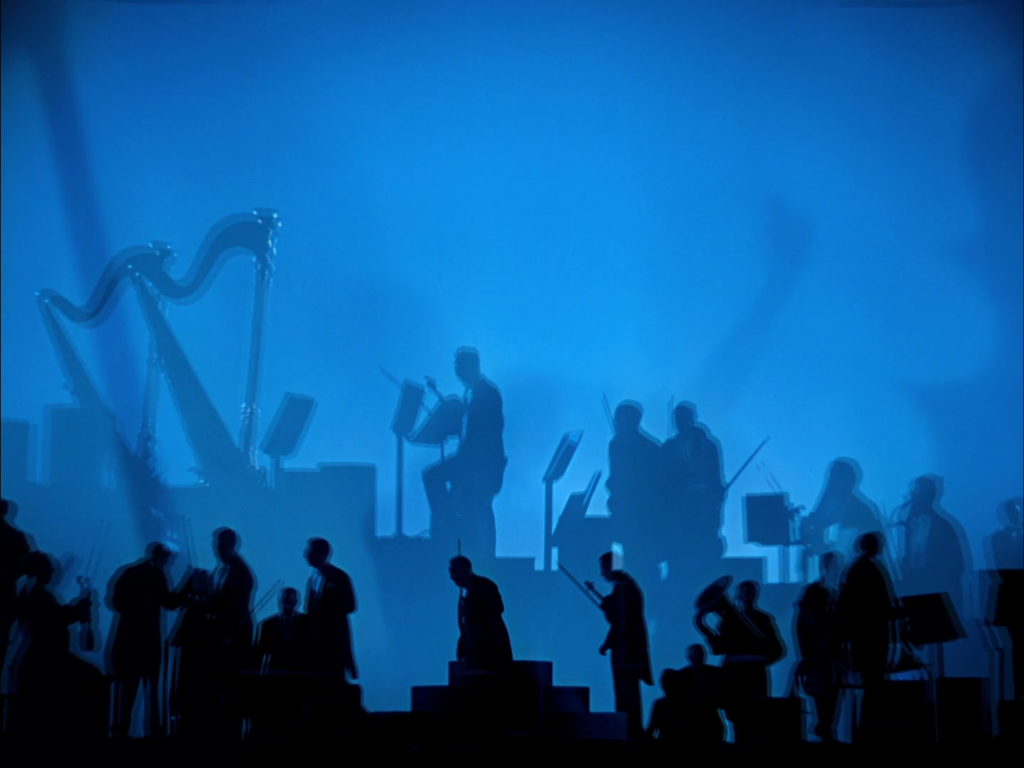
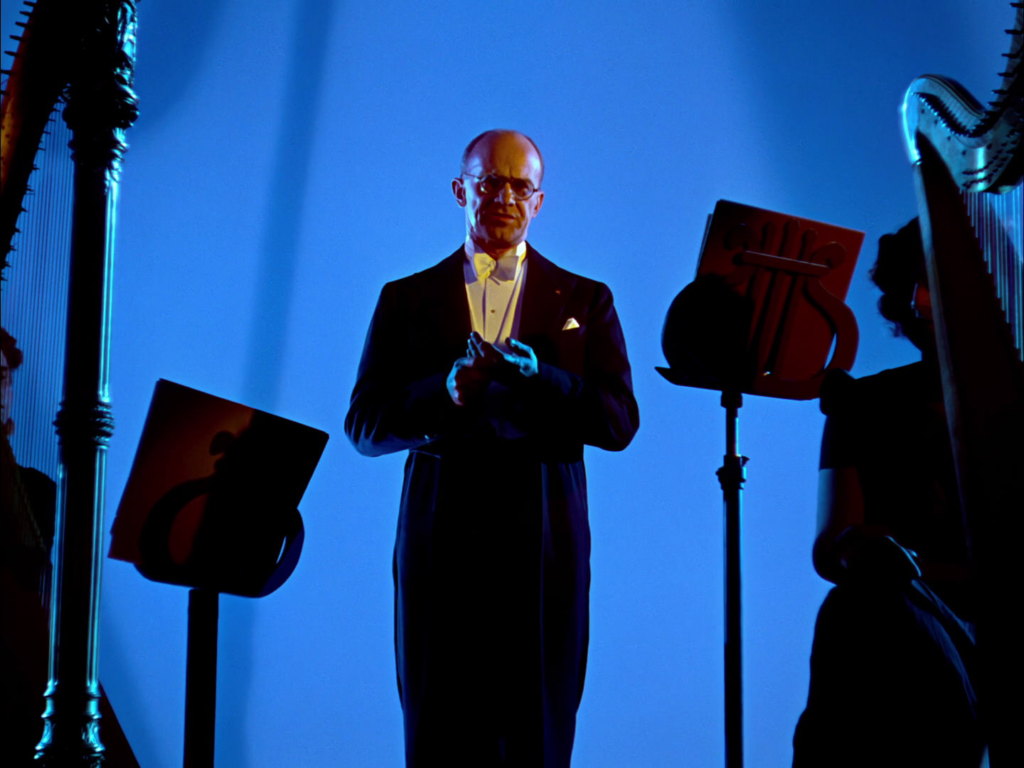
I hate to start off with some criticism, but Taylor introduces each of the movie’s segments and, boy, does he not have much of a screen presence! Despite some playful humor injected into his speeches, he comes across as dry and boring and doesn’t convey the awesome power of either the classical compositions or the accompanying imagery at their best. What’s more annoying is that for some of the pieces, mainly The Rite of Spring and The Pastoral Symphony, he goes on and on, giving away practically every detail of what the viewer is about to see. Most of the segments are pretty self-explanatory and don’t need this. With Fantasia, Disney animation was trying to show that it could be Serious and Adult. But these introductions feel like they were created to tell viewers how Serious and Adult they were instead of actually being Serious and Adult as the main parts of the movie happily are. Worse, these parts of movie feel like they were created to make it Educational! To the extent that they add to the viewer’s enjoyment by explaining the intents of the composers and the twists Disney did on them, I wish this information could have been provided in a pamphlet handed out to theatregoers. But of course that would have been far too expensive and inconvenient. Anyway, on to the first segment.
Bach’s Toccata and Fugue in D Minor
We begin with conductor Leopold Stokowski ascending his podium and beginning to conduct the orchestra. (A conductor on a high place becomes a visual motif in the movie.) As he does so, colorful lights appear as if he’s conducting images as well as just music.
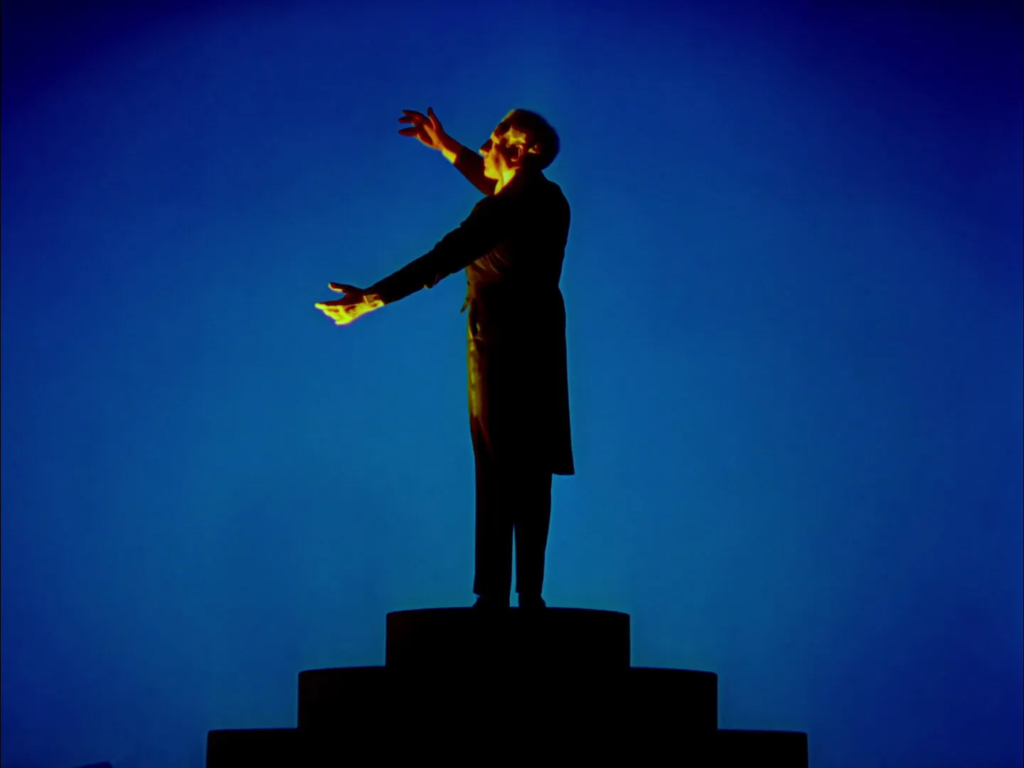
The first half of this part consists of silhouettes of the musicians, playing their instruments against colorful backgrounds.
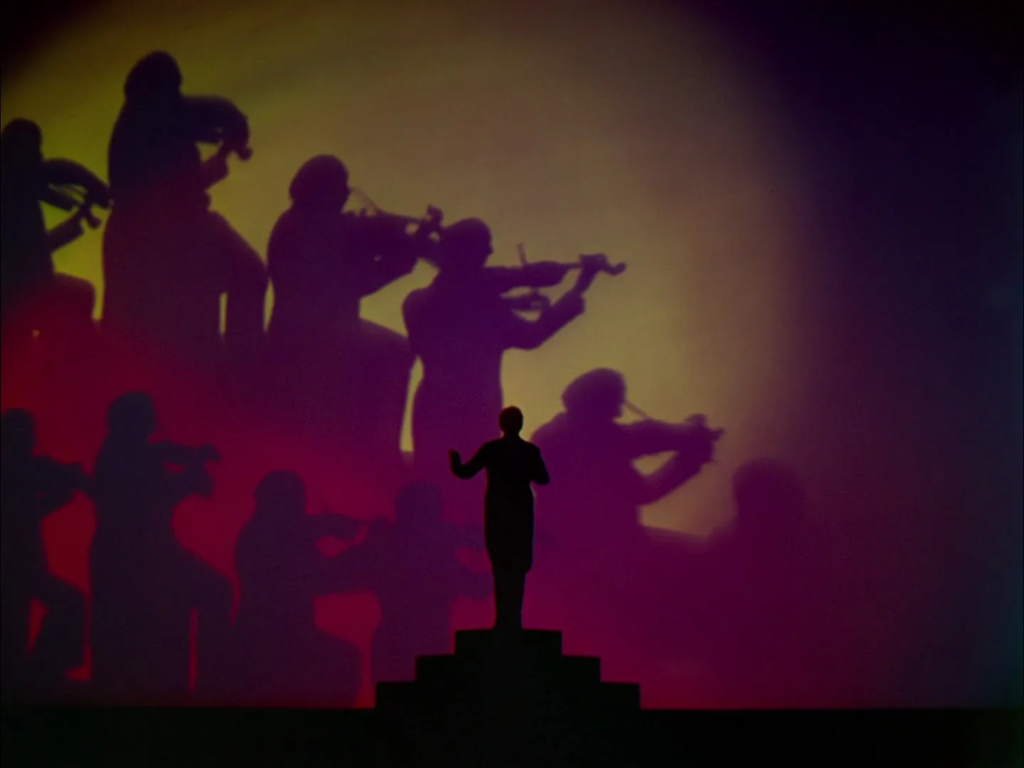
Then it shifts into a series of abstract images, at first obviously corresponding to the individual instruments, then growing gradually more surreal before we’re brought back to reality and Stokowski. This is definitely one of the most potentially boring parts of the movie, especially if you aren’t already a fan of symphony music. There’s a long time where we just watch ordinary musicians playing against a strange background. And even when the abstract imagery starts, it’s debatable how engaging it is. Some of the images have a haunting evocative power.
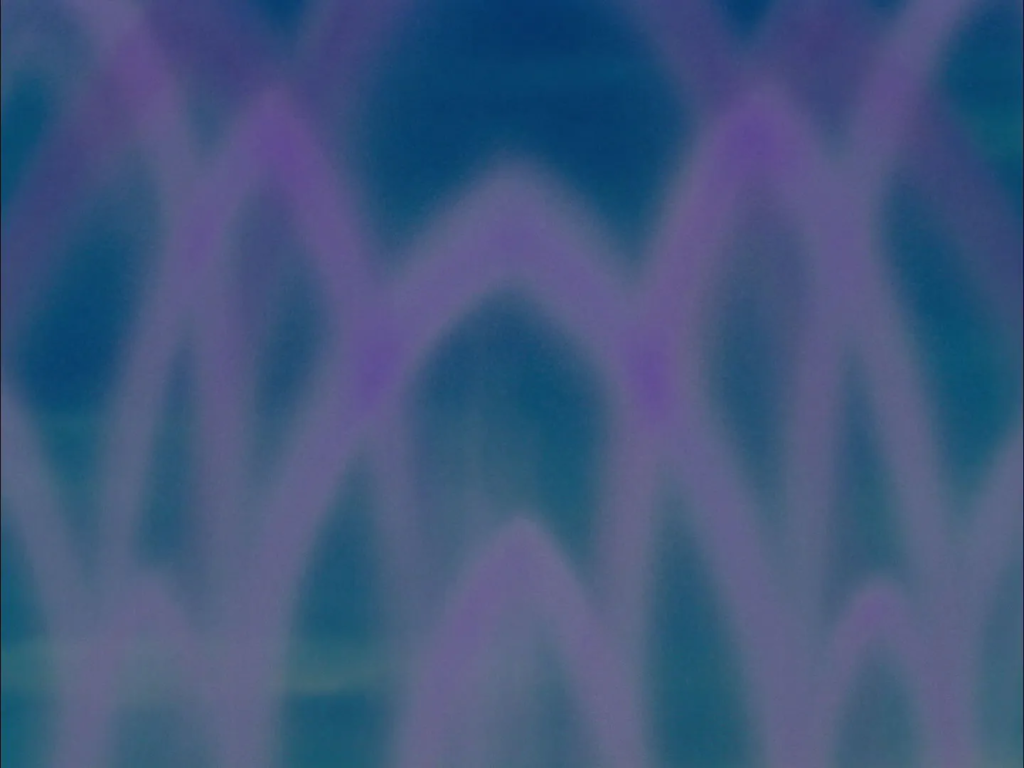
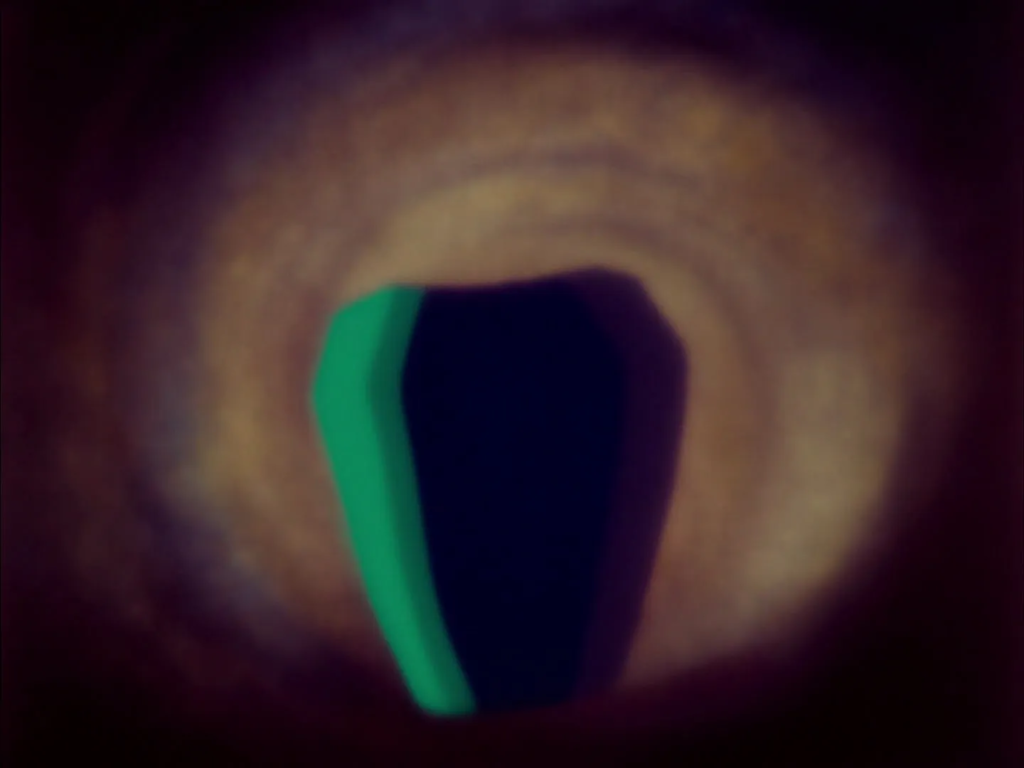
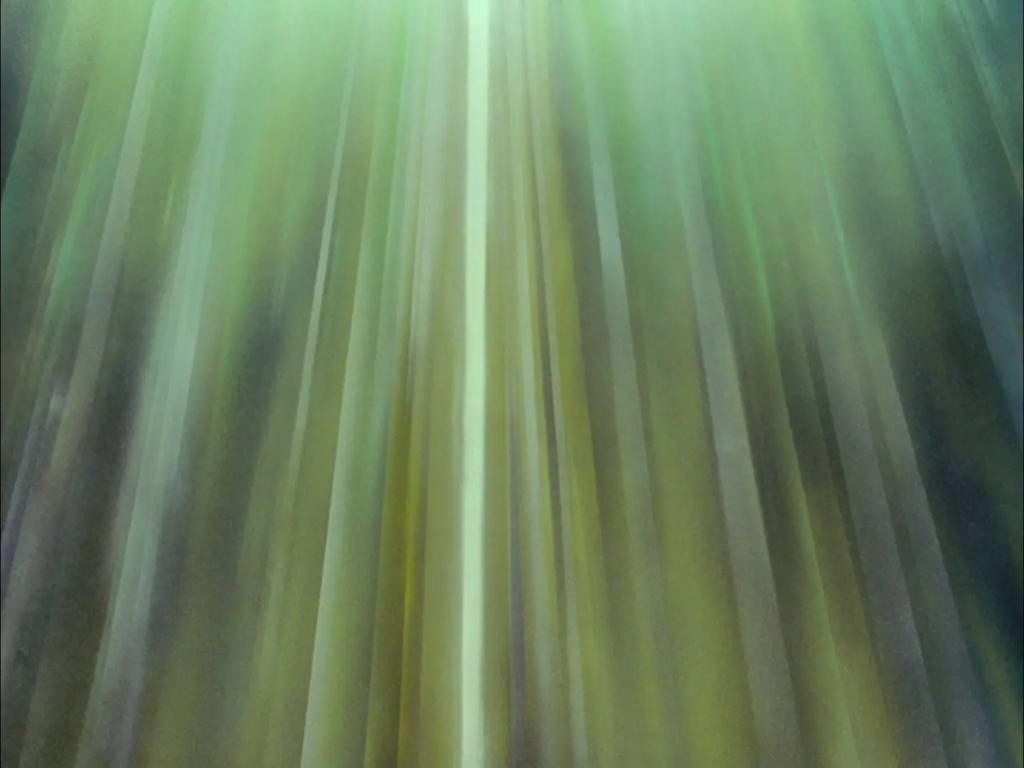
Others just…are.
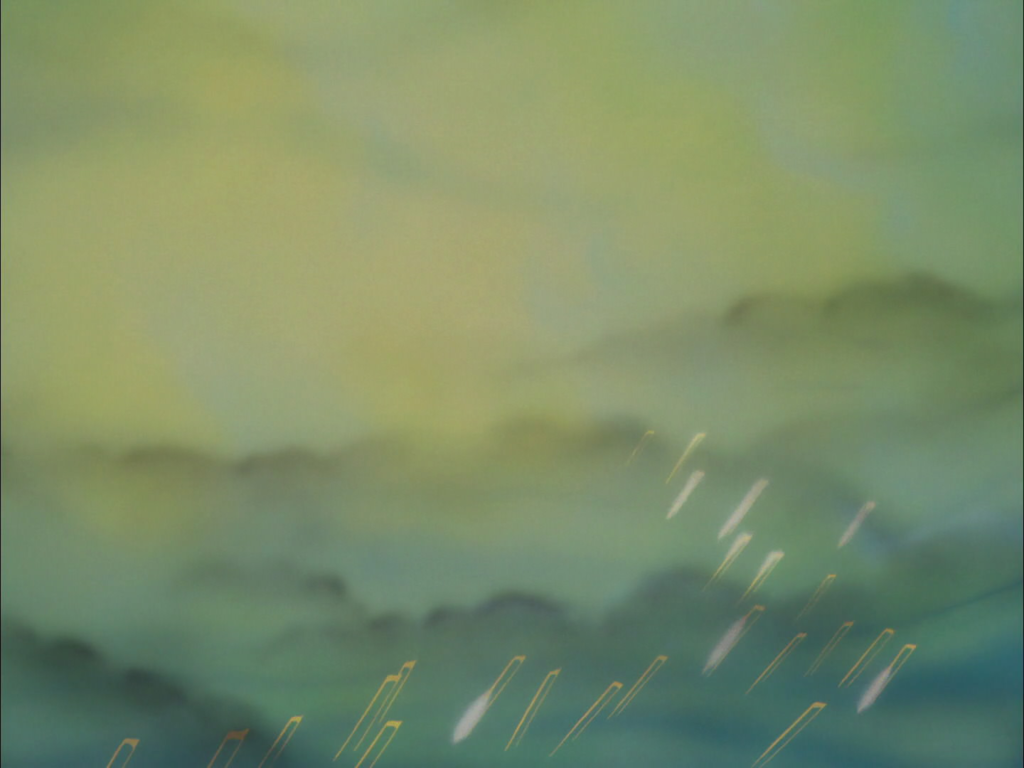
I feel that’s sort of the point though. This segment’s job is to give the audience a very basic example of the connection between music and imagery in this movie. It’s not trying to do much else. The risk in that is that the audience will be uninterested in something so simple. The art to it is that something so simple helps transition the audience into a state of mind in which they can easily accept more complex offerings of the movie’s bread and butter. As Deems Taylor explains, in one of the more necessary of his intros, this segment represents the mindset of an audience member during the first song in a concert. “At first, you’re more or less conscious of the orchestra…than the music begins to suggest other things to your imagination.” Seen from this perspective, the segment becomes an indispensable part of the viewing experience, though I doubt anyone would rank it as the best part. And the piece of music is so powerful and the imagery, at its best, so beautiful that I have to give it a thumbs up.
Tchaikovsky’s The Nutcracker Suite
This segment is basically a ballet, a ballet performed by tiny, weather-and-climate-controlling fairies, anthropomorphic flowers and mushrooms and a weirdly sexy goldfish.

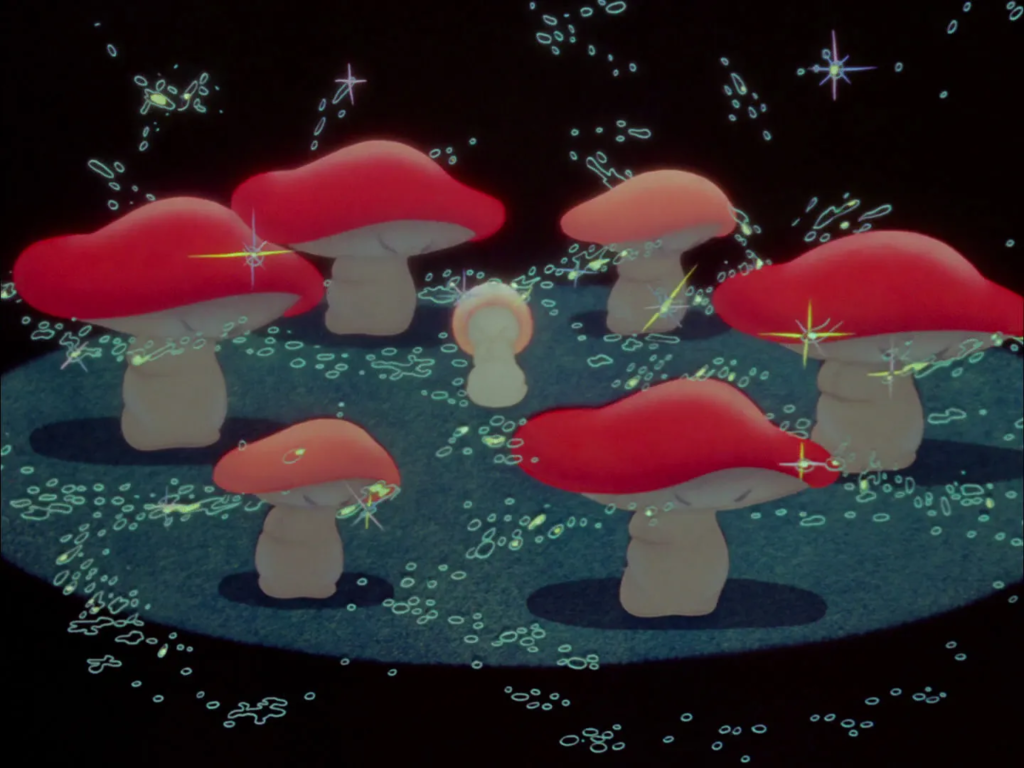
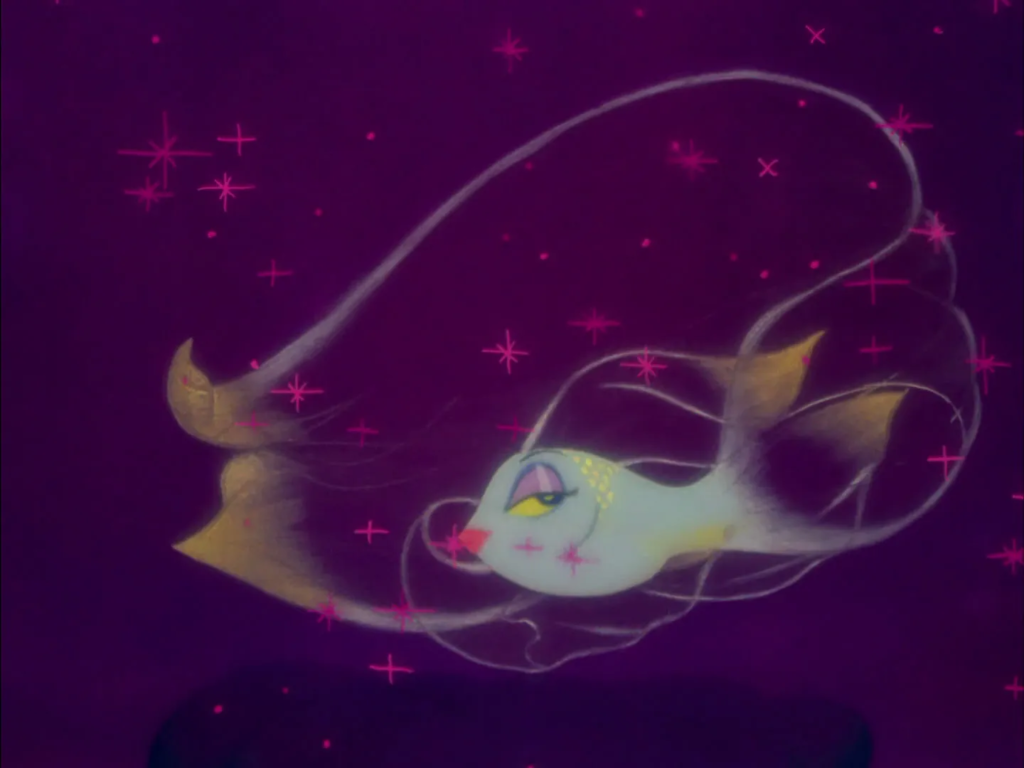
Being a ballet, there’s not much that happens except for dancing and for many viewers, that’s going to get boring very quickly. When I’m not in the mood, I find it that way myself. But when I am in the mood, I love it. From the description I gave, you’d expect this part to be mainly cute. But that description drastically undersells the beauty of the visuals.
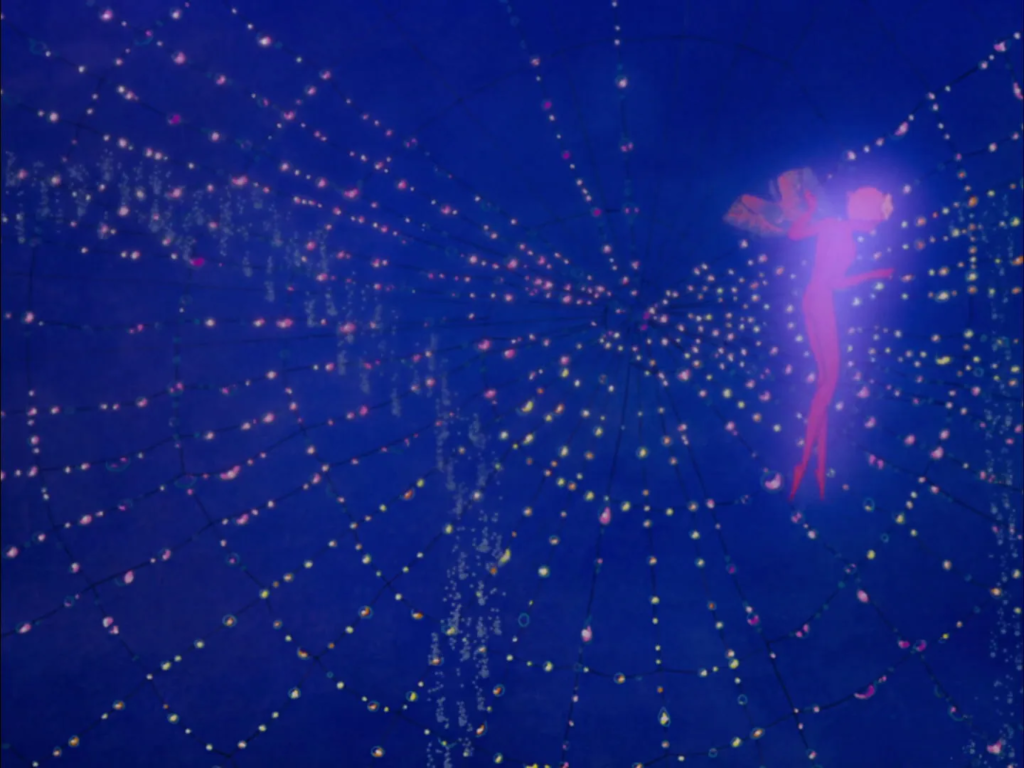
And there’s also a cleverness to the designs of the flower dancers beyond simple cuteness.
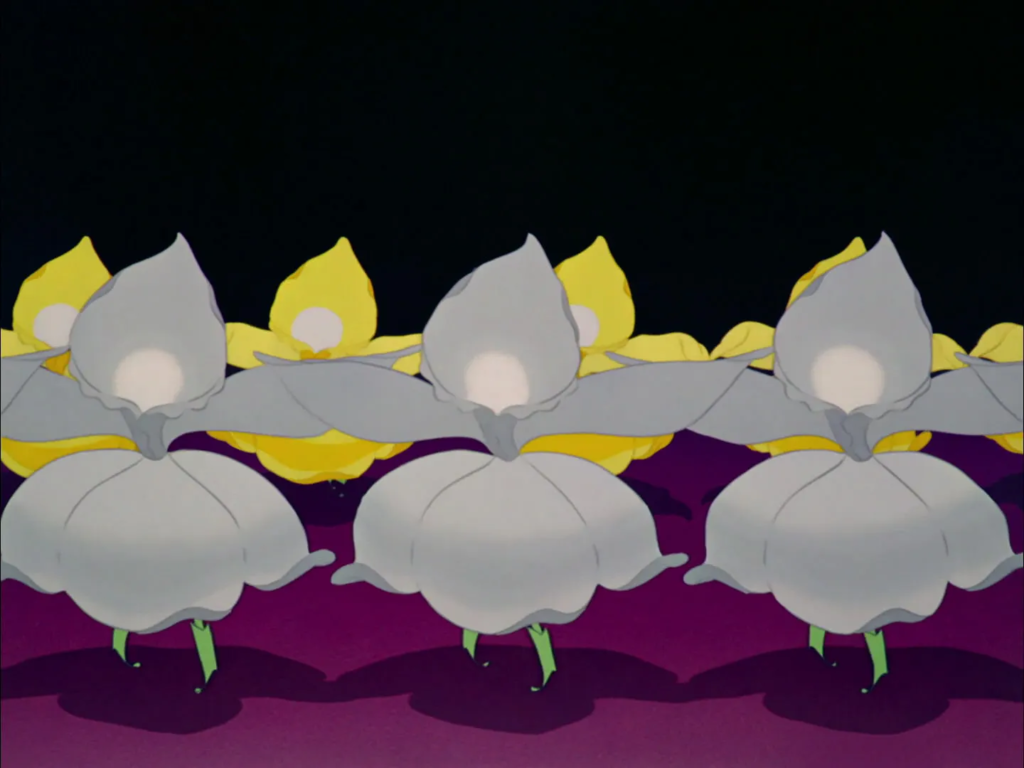
If nothing else, this segment is worth watching for a lovely moment when two windblown autumn leaves appear to be dancing with each other.[4]A much later and more crowd-pleasing Disney animated movie would do something similar with a pair of floating lanterns.
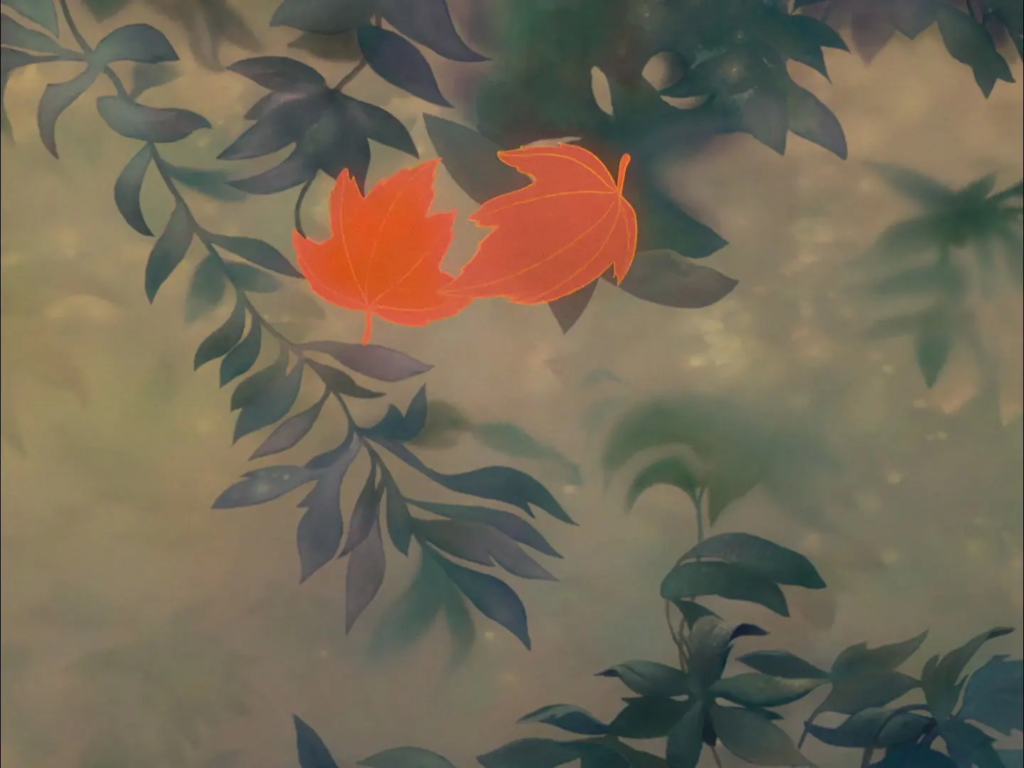
Basically, this is like a sunset or a mountain. You don’t watch it expecting a lot of action. You’re just supposed to stay still and marvel.
Dukas’s The Sorcerer’s Apprentice
If you’ve heard of any part of this movie, it’s this, the first segment to tell a story. In fact, I’m not even going to bother describing it.
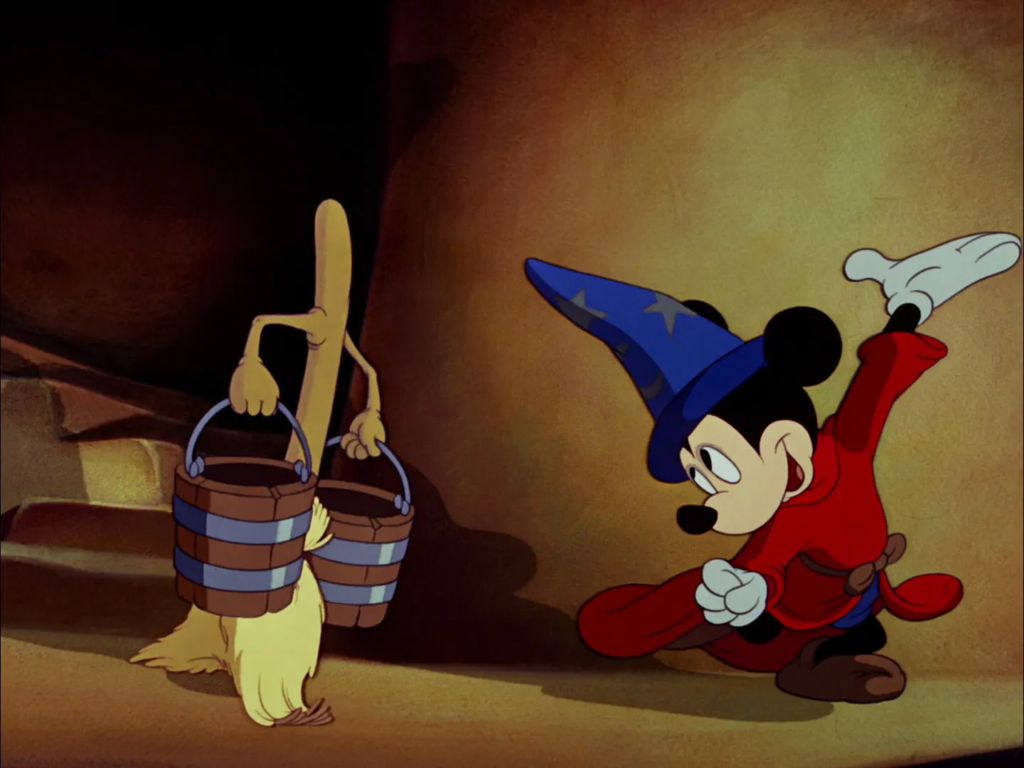
I’m not sure it deserves that fame. Unlike most of the other segments, it’s not particularly unique or ambitious for a Disney animated short. The character animation is great but then Disney movies generally have strong character animation. The backgrounds are probably the least interesting in the movie, though their dark, cavernous beauty does serve to create an appropriately spooky atmosphere for the story.
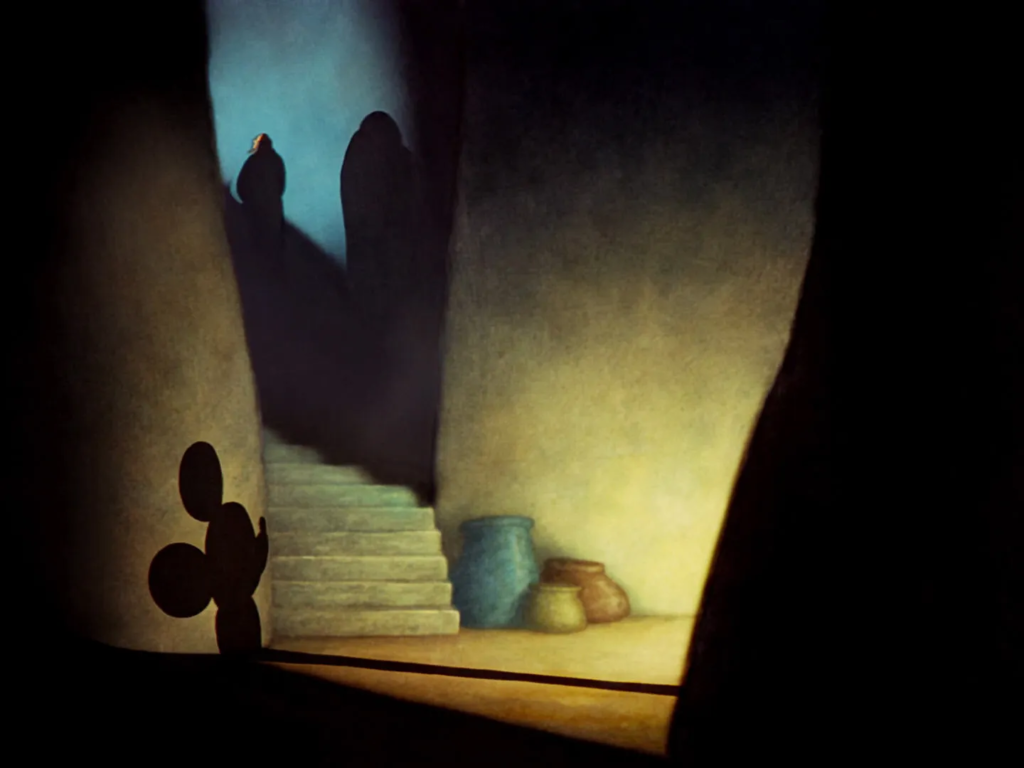
But not standing out doesn’t make it not a great short. It’s basically just a great example of wordless visual storytelling. I admit I found the lack of humor in it a bit jarring on a first viewing, given that it stars a famous cartoon character, even if Mickey Mouse is considered the least funny of Disney’s trio of toon stars, Mickey, Donald and Goofy. But if you’re openminded about the idea of a Mickey Mouse short that’s not comedic, it’s pretty great.
Stravinsky’s The Rite of Spring
I’ve heard this described as the most boring part of Fantasia. I don’t get that at all. For me, this is where the movie really starts to get great. It opens with a breathtaking tracking shot that takes us through the galaxy to a prehistoric Earth.
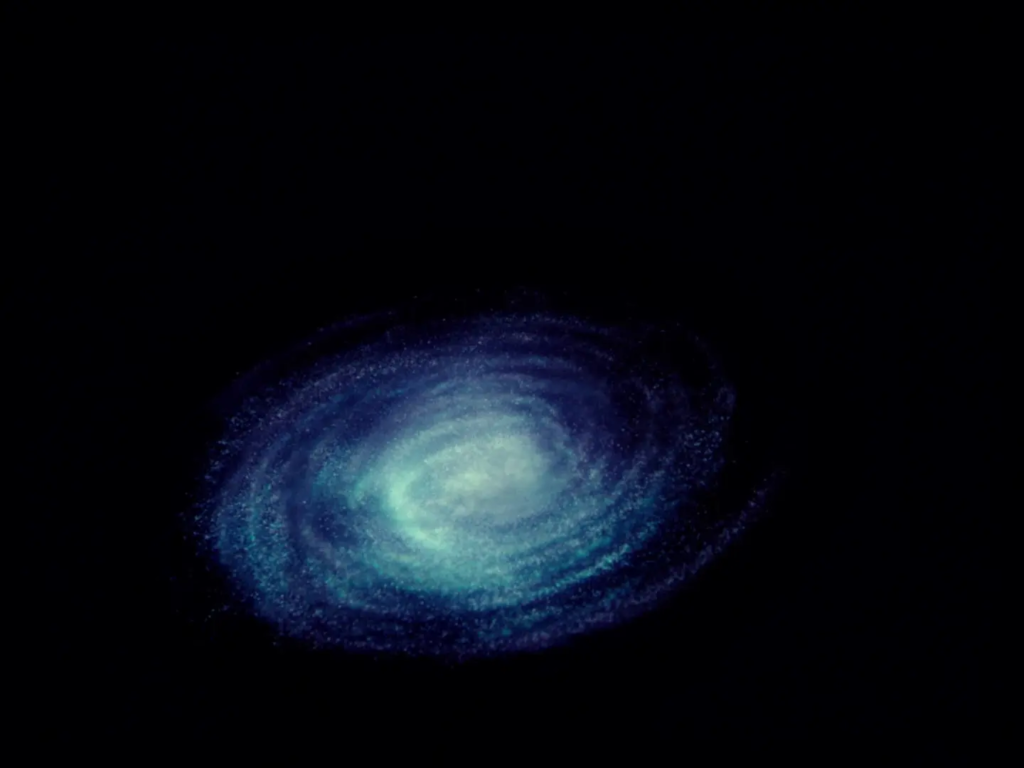
We see the evolution of the dinosaurs and their eventual extinction. The naturalistic animation of the gigantic lizards is awesome, and the combination of it with Stravinsky’s pounding, edgy music makes this easily one of the most exciting parts for me.
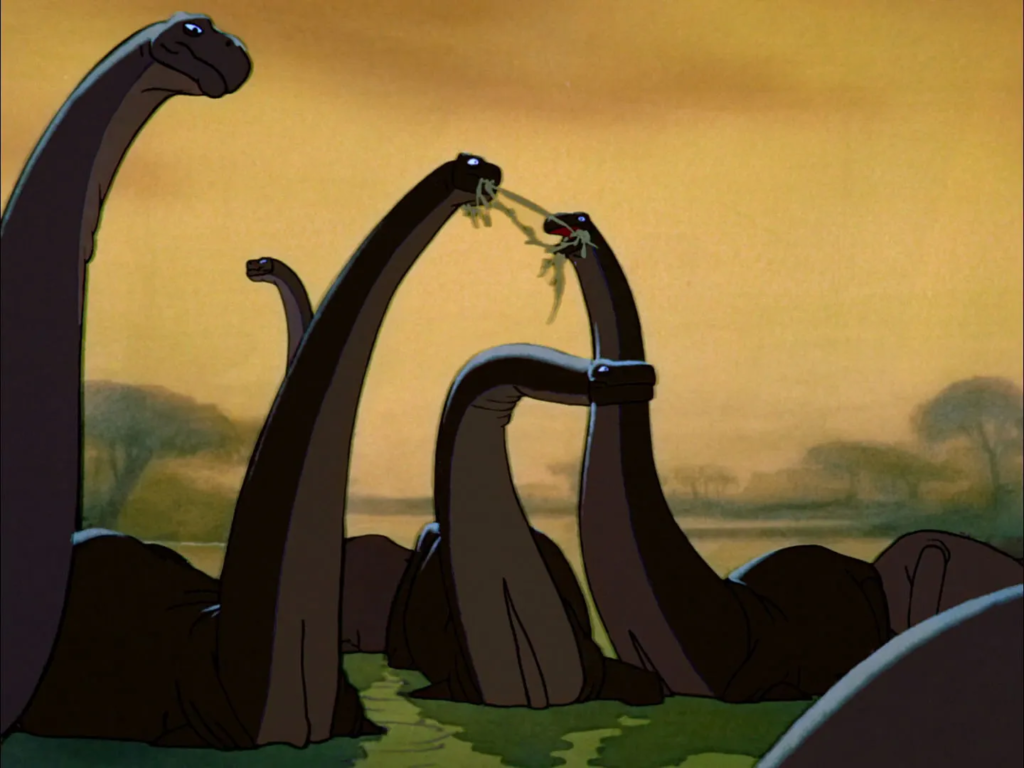
Readers who know me personally might question how I can enjoy this section of the movie so much when my religious beliefs are in conflict with the view of early history it portrays.[5]Others would argue they aren’t in conflict and that the parts of the Bible describing the creation of the world should be interpreted figuratively. I’d argue they don’t really line … Continue reading Well, for one thing, science itself has evolved since this movie’s release to the point that few modern scientists would regard this movie’s portrayal of evolution or Earth’s prehistory as strictly correct. (Even to the extent that Disney was trying to make something scientifically accurate, they weren’t going to let the scientific consensus get in the way of making something cool.)
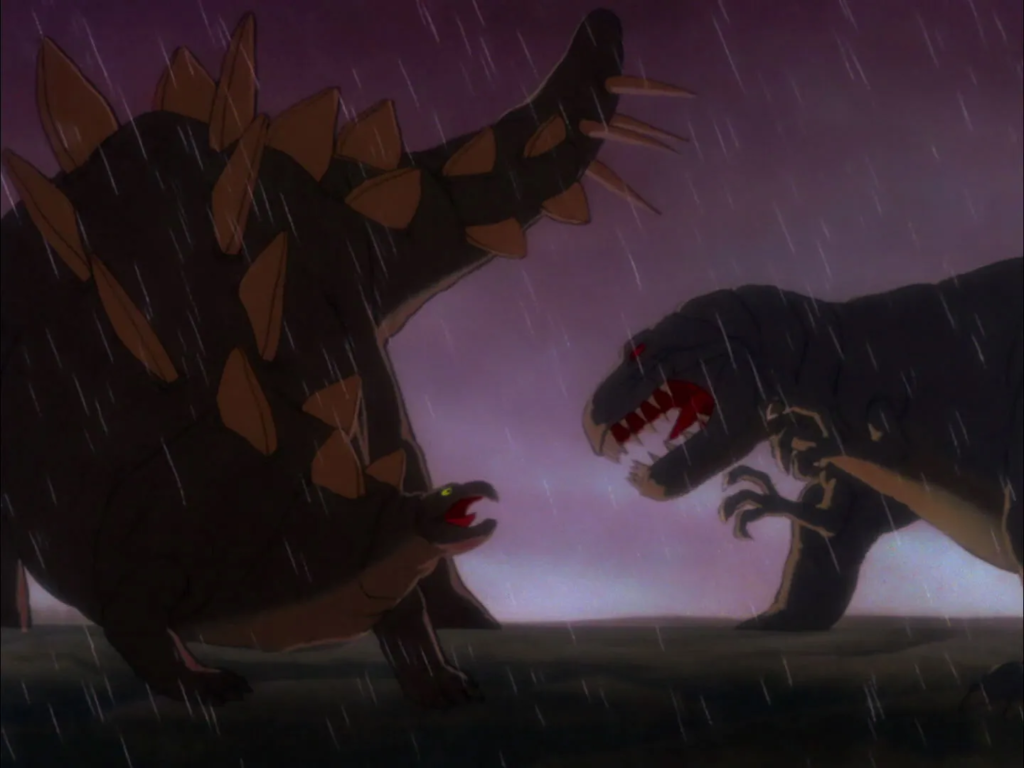
Another thing is that Fantasia feels like it’s representing different worldviews with its different shorts just as it represents different composers without really committing to any particular one. This segment portrays an atheistic view of the world. The Pastoral Symphony, which is coming up, portrays a pagan worldview and Ave Maria a Roman Catholic one. The Rite of Spring’s worldview is also a very bleak, dog-eat-dog one, with a lot of emphasis put on predation and the survival of the fittest.
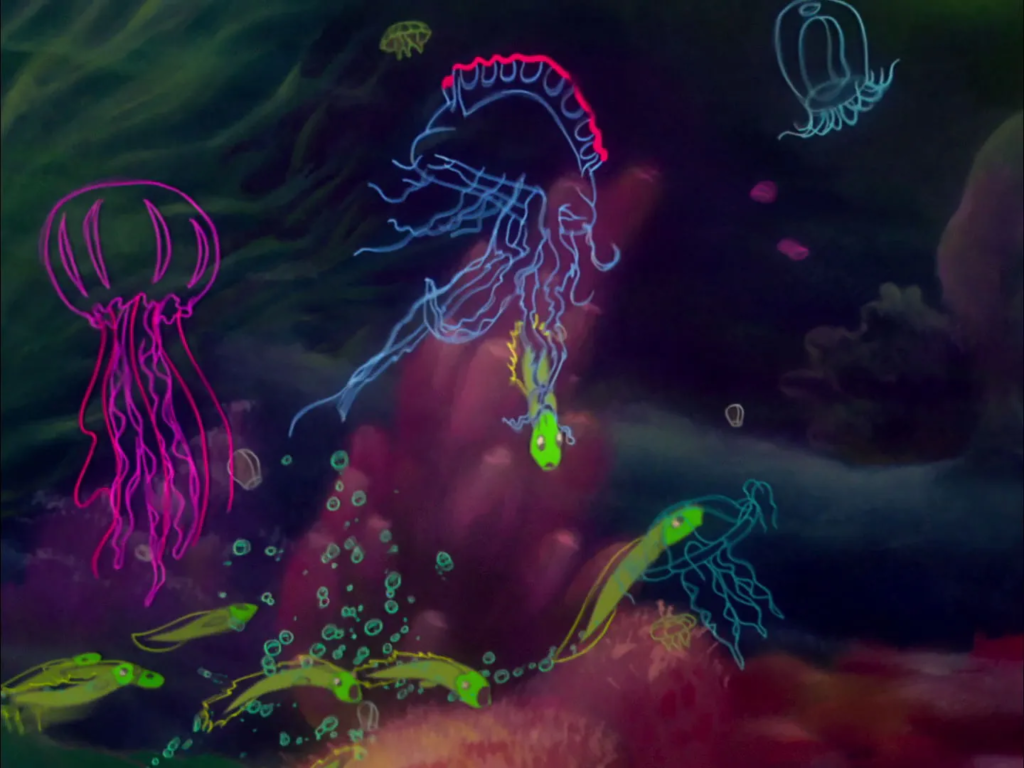
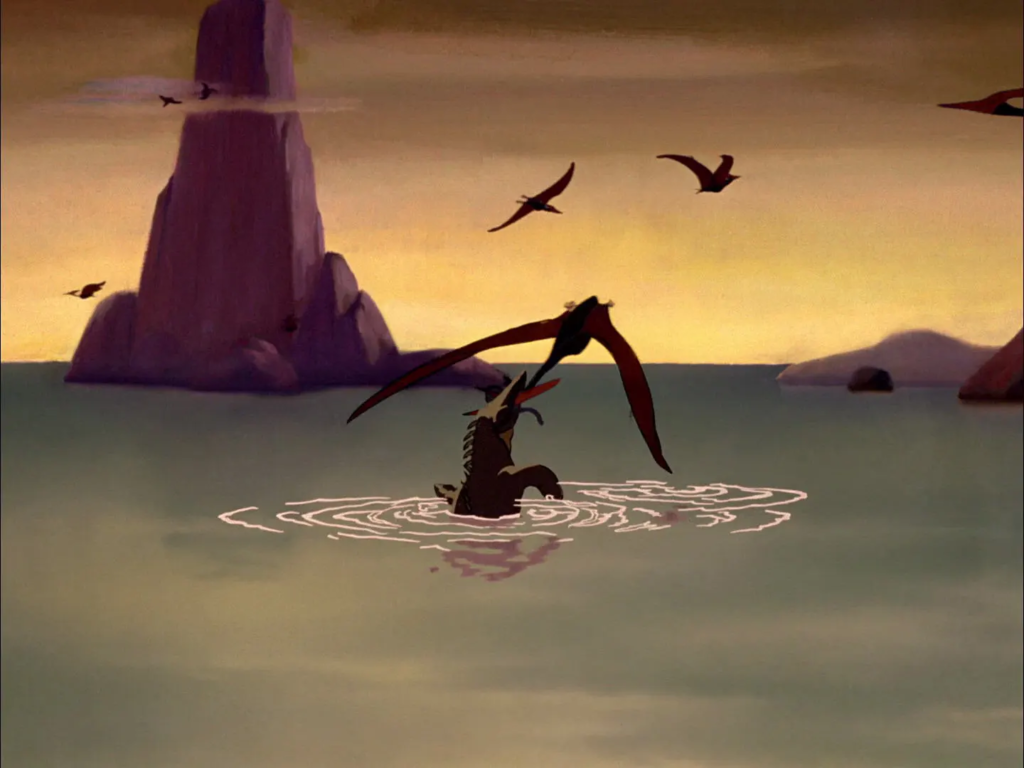
And then of course, there’s the ending with the dinosaurs wandering around hopelessly before all going extinct, leaving only their bones, if that.[6]Apparently, at one point they wanted to end with early man finding fire, but this was deemed too controversial. I wonder if such an ending would have made the segment come across as more optimistic … Continue reading It’s not the happy ending we expect from Disney animation and it’s not alone among Fantasia’s segments in that.[7]The Sorcerer’s Apprentice ends with Mickey getting his butt swatted and The Dance of the Hours ends with what appears to be a symbolic representation of mass rape. Seriously. This is part of what makes Fantasia so fascinating for fans of Disney animation. It represents a time when Disney animation was less strictly family friendly and much of its subject matter is not what you’d expect from the studio. (Have I mentioned that there are topless women in this thing?) Even if you compare it to the two Disney animated features that came before it, Snow White and the Seven Dwarfs and Pinocchio, it’s strikingly different from either of them. One wonders what kind of movies Disney would have made if Fantasia’s initial theatrical run had been more financially successful. Might they have eventually produced accurate adaptations of The Fox and the Hound, The Little Mermaid and The Hunchback of Notre Dame? The imagination boggles.
Meet the Soundtrack
After an intermission, we get an unusual, even for this movie, segment where Deems Taylor introduces the audience to a visual representation of Fantasia’s soundtrack, which changes shape based on the sound it makes.
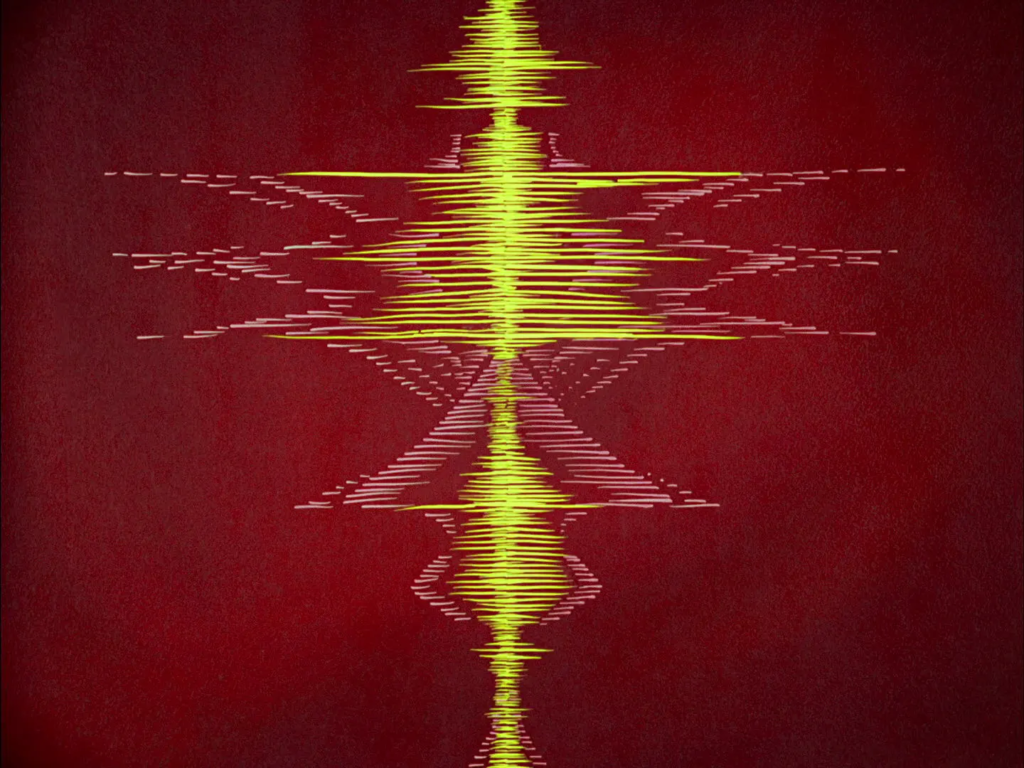
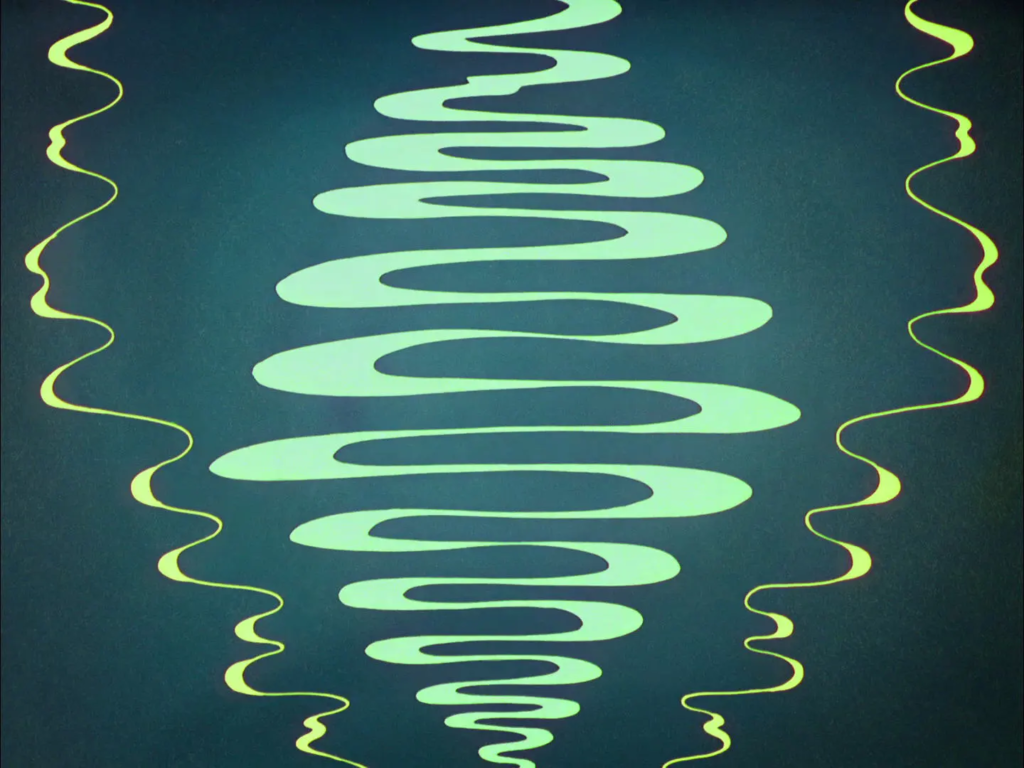
It’s interesting but so similar in concept to the Toccata in Fugue segment that one wonders if it was really necessary. Maybe it should have actually replaced it since it’s the less slow of the two.
Beethoven’s The Pastoral Symphony
This segment shows a day in the life of classical mythic creatures living in the countryside. (It’s a rather inaccurate version of classical mythology that features plural cupids and pegasi, and centaurs as a two-sex race. I say that as an observation, not necessarily a criticism.) The visuals are much more recognizably Disney-esque than those of The Rite of Spring or even The Nutcracker Suite. Practically all the characters have round, squishy looking features, typical of Disney shorts, with an emphasis on cuddliness. Part of me wishes this short could have gone for something more epic and awe-inspiring in keeping with the grandeur of classical mythology.
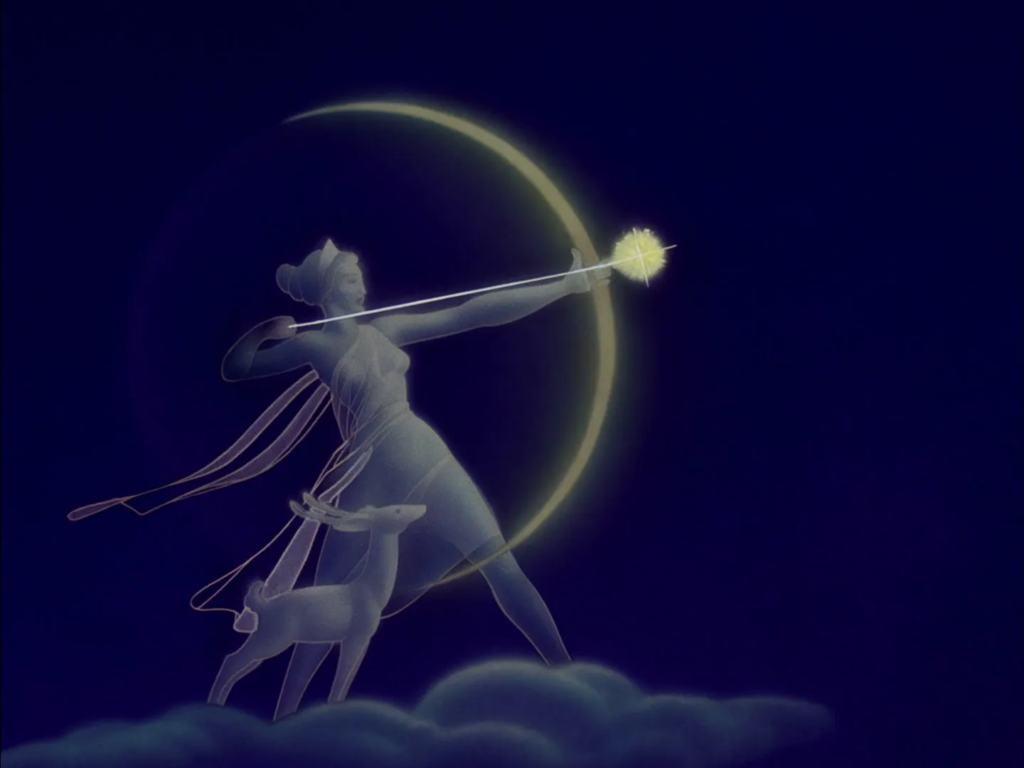

But just because I enjoy things like The Rite of Spring for their departures from a typical Disney aesthetic doesn’t mean I think the typical Disney aesthetic is bad. If that were my opinion, I probably wouldn’t have started this series in the first place. I actually find this to be one of the most charming sections of the movie. It’s filled with sweet little details.
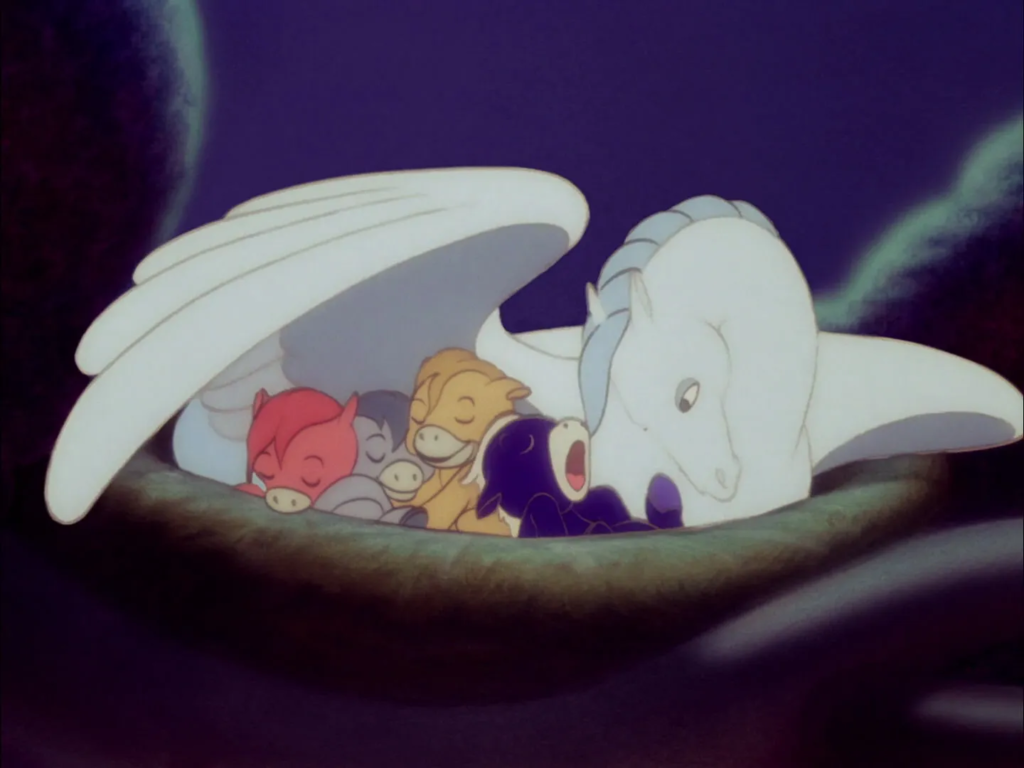
While it’s not one of the plotty segments, there’s always something happening and moreover the characters always convey a specific emotion, unlike, say, the ballerinas in The Nutcracker Suite. This means it risks being boring far less than either that segment or Toccata in Fugue, even if I find those more interesting in the technical sense of the term. And hey, being deliberately cute doesn’t mean something can’t be emotionally powerful. This image of a mother unicorn desperately trying to shield her foals from a thunderstorm gets to me every time.
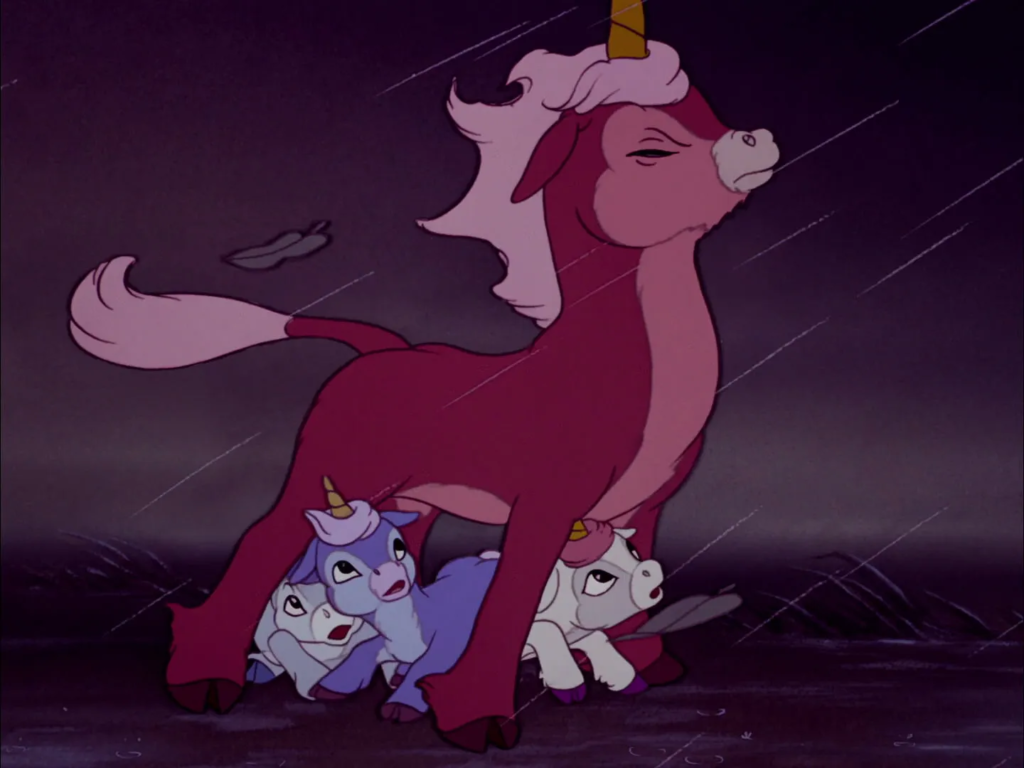
Speaking of images which raise strong emotions, this segment is mildly infamous for featuring a racist caricature which has since been edited out. I’m not normally in favor of editing out racist parts of old books and movies. But the image is both so ugly and so irrelevant to the scene’s main business that I’m grateful to Disney for removing it and allowing people to enjoy this part of the movie without cringing.[8]Two black characters, who couldn’t be edited out, remain. While their puffy lips are stereotypical, they’re not as bad as the cut caricatures and while they’re also subservient to a … Continue reading
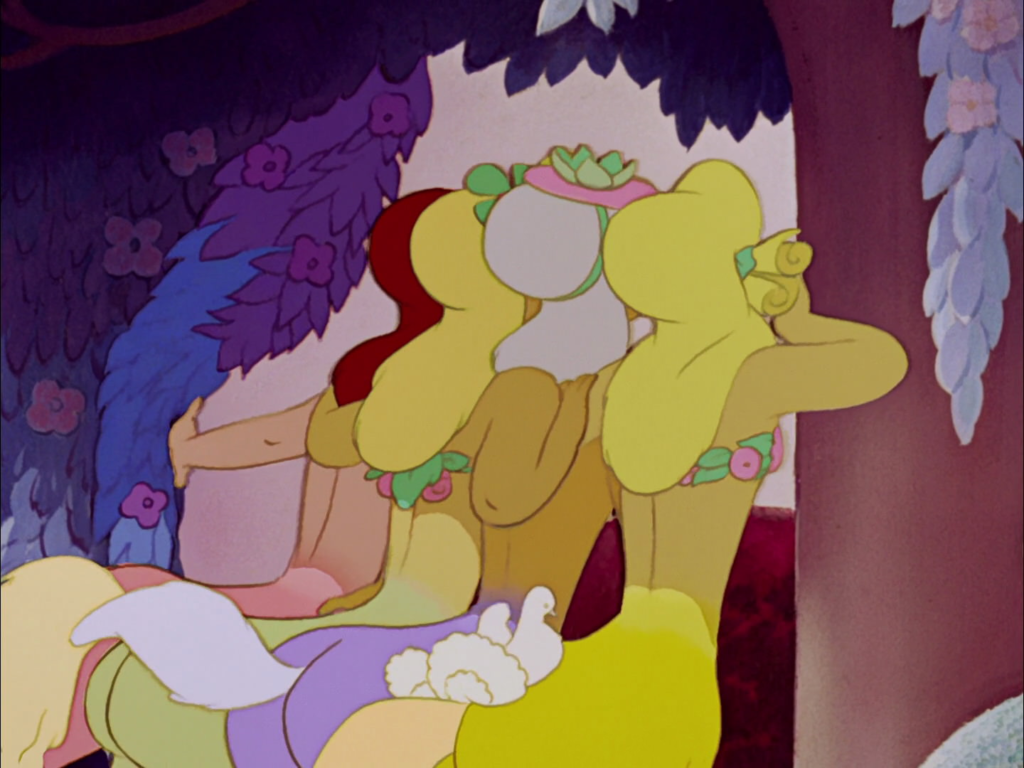
What might still make some viewers cringe are this segment’s overly bright colors. Out of context, I find them too garish. But coming after the dark and gloomy visuals of The Sorcerer’s Apprentice and The Rite of Spring, not to mention the shadowy concert hall of Fantasia’s interstitials, I find them rather refreshing.
Ponchielli’s Dance of the Hours
I have to give credit to Deems Taylor’s introduction to this short for explaining exactly what it is-a ballet with different dancers representing the different hours of the day-without giving away that the dancers are goofy animals, making the following comedy even funnier.[9]Of course, I’ve just given it away, ruining the reveal, but I couldn’t find a way around it. I hesitate to describe this one much because to do so would give away the great visual gags. I’ll just say it’s really fun to watch. I particularly love the design of the hippo ballerina.
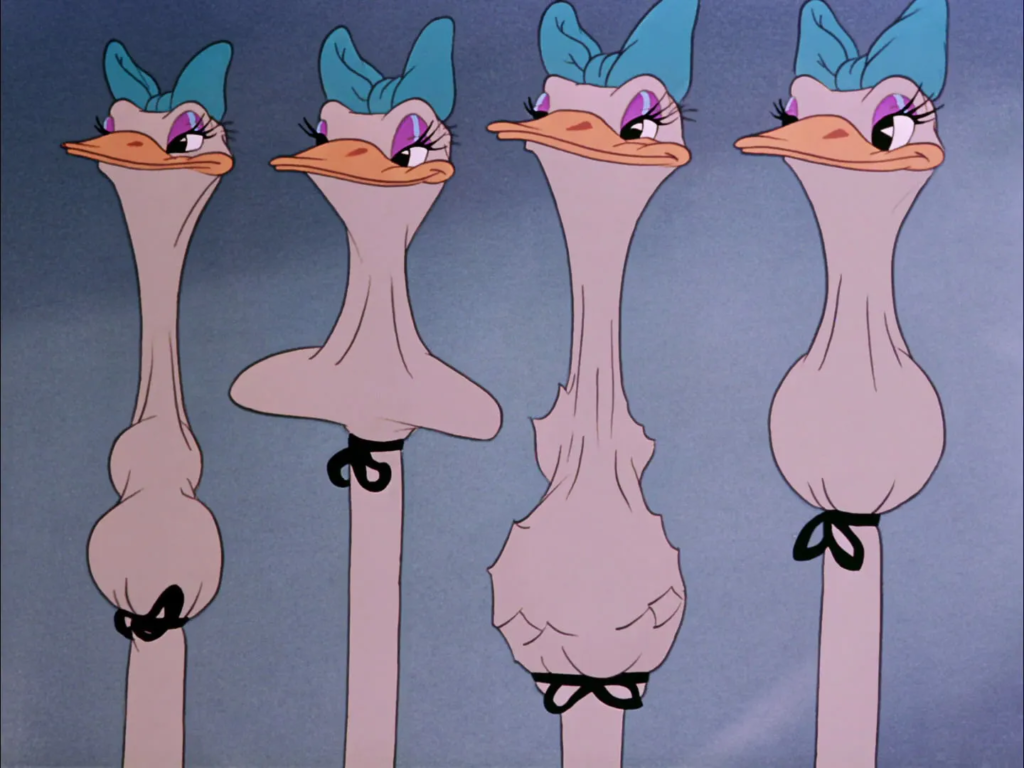
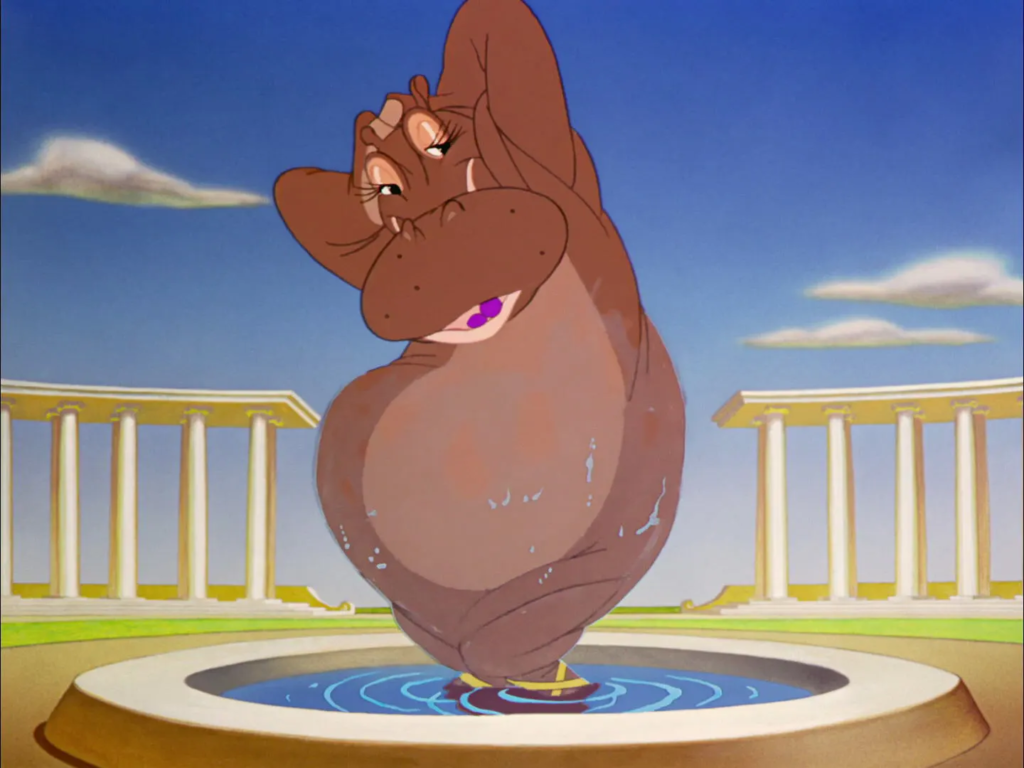
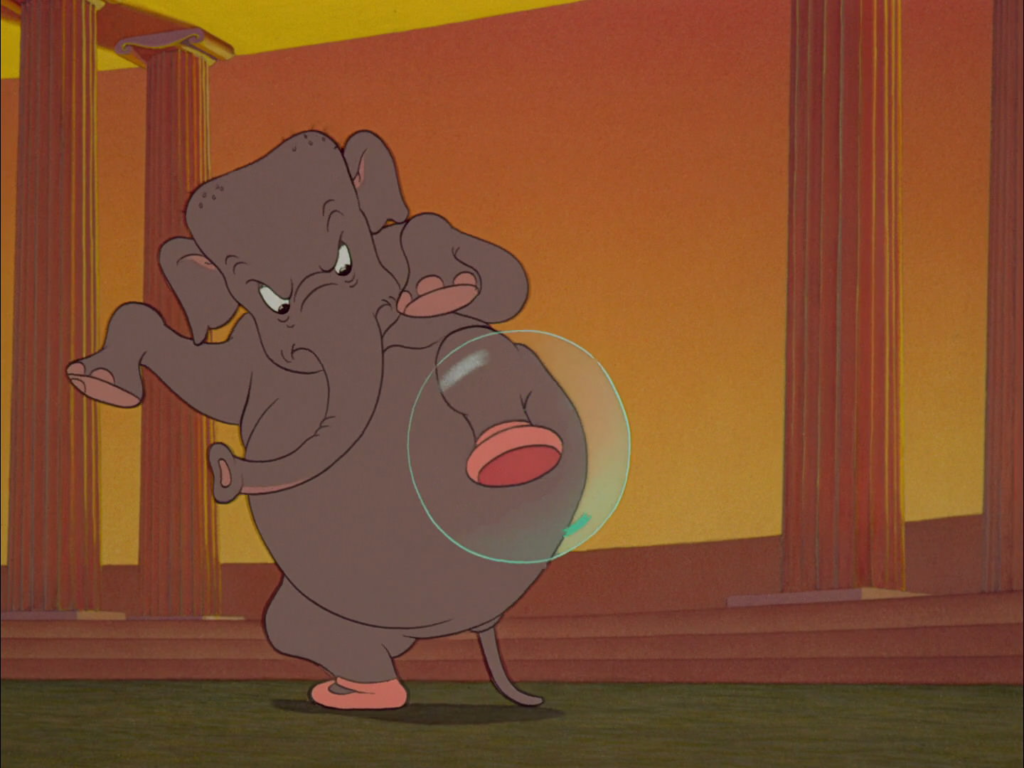
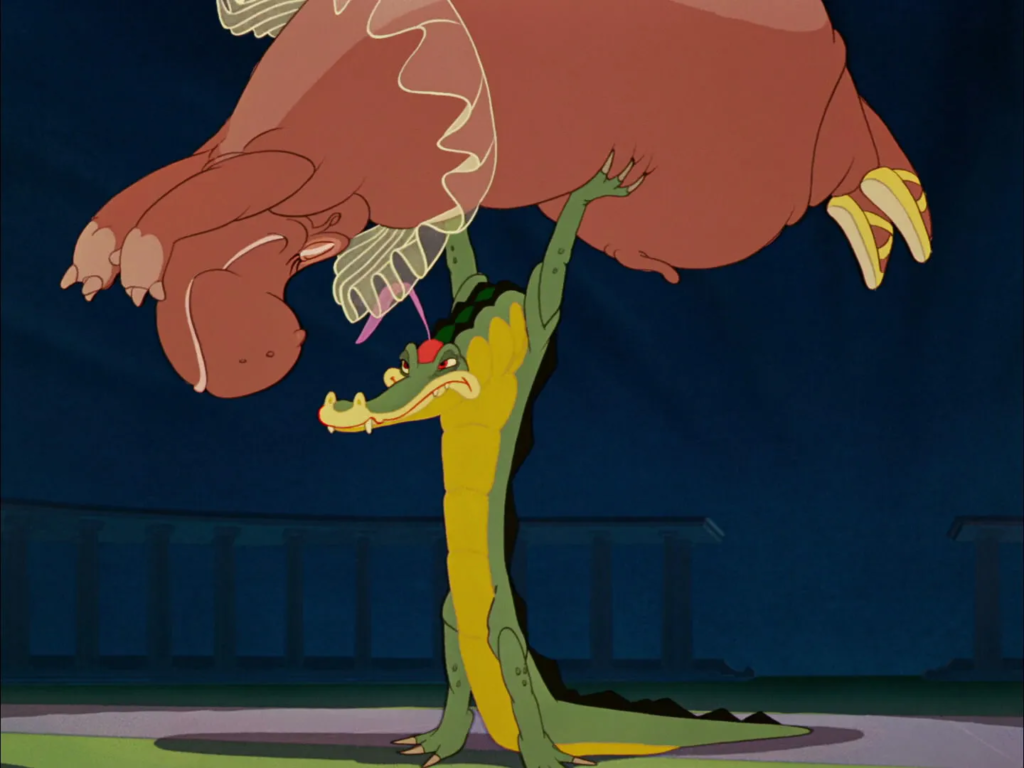
Mussorgsky’s Night on Bald Mountain/ Schubert’s Ave Maria
After two lighthearted and stereotypically Disney-esque segments, we get something dark and dramatic for the finale. It’s actually two segments combined in one. Night on Bald Mountain features Chernabog, the Slavic god of darkness, who lives in the titular mountain and awakens one night of the year to summon lost souls and demons to dance for him torturously.
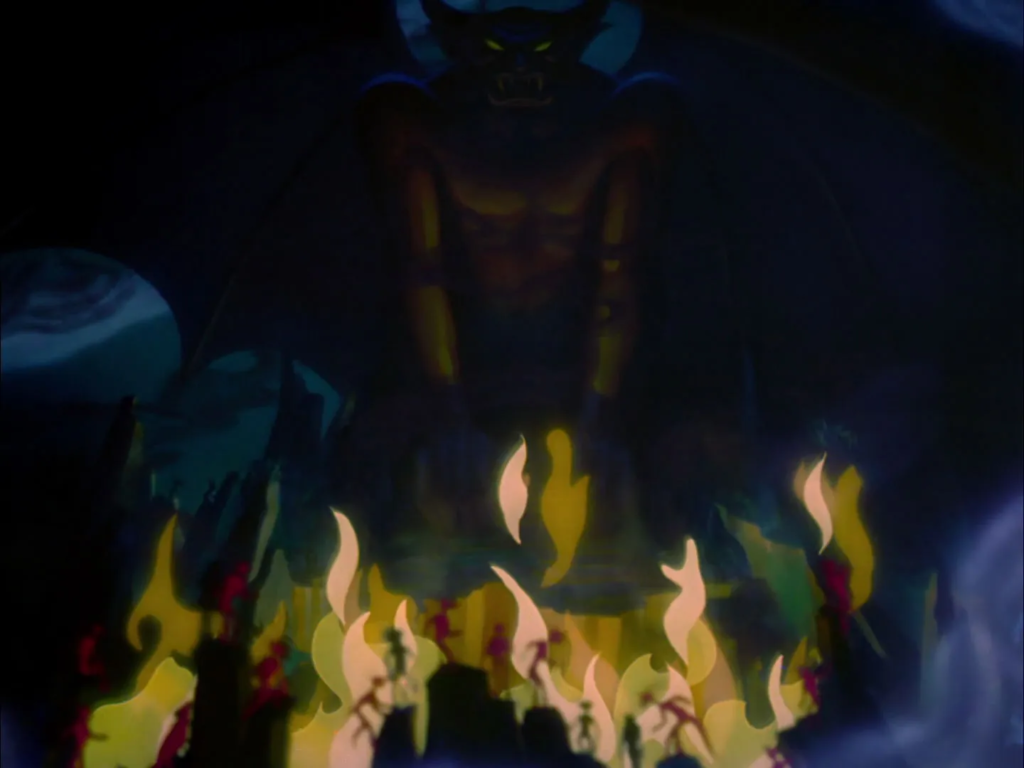
The grotesque imagery is masterfully horrifying. I’m not knowledgeable enough about animation techniques to know what effect they used to give the ghosts that chalky, not-quite-there look [10]The same thing is used in The Rite of Spring for foam and volcanic fumes. but I love it.
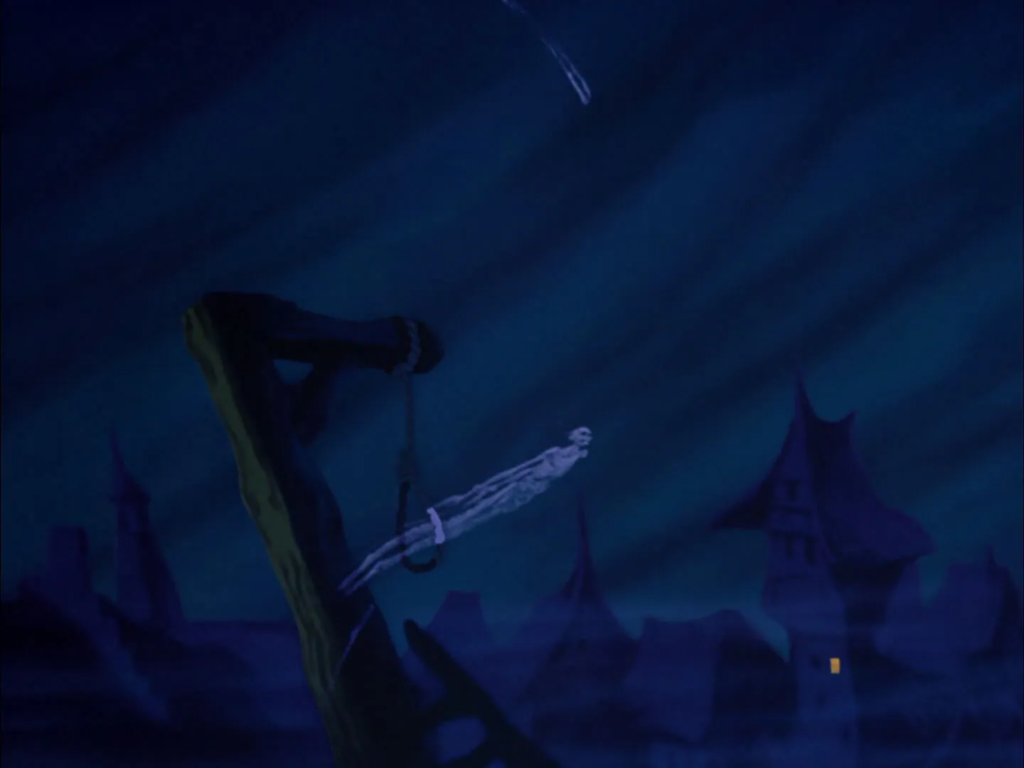
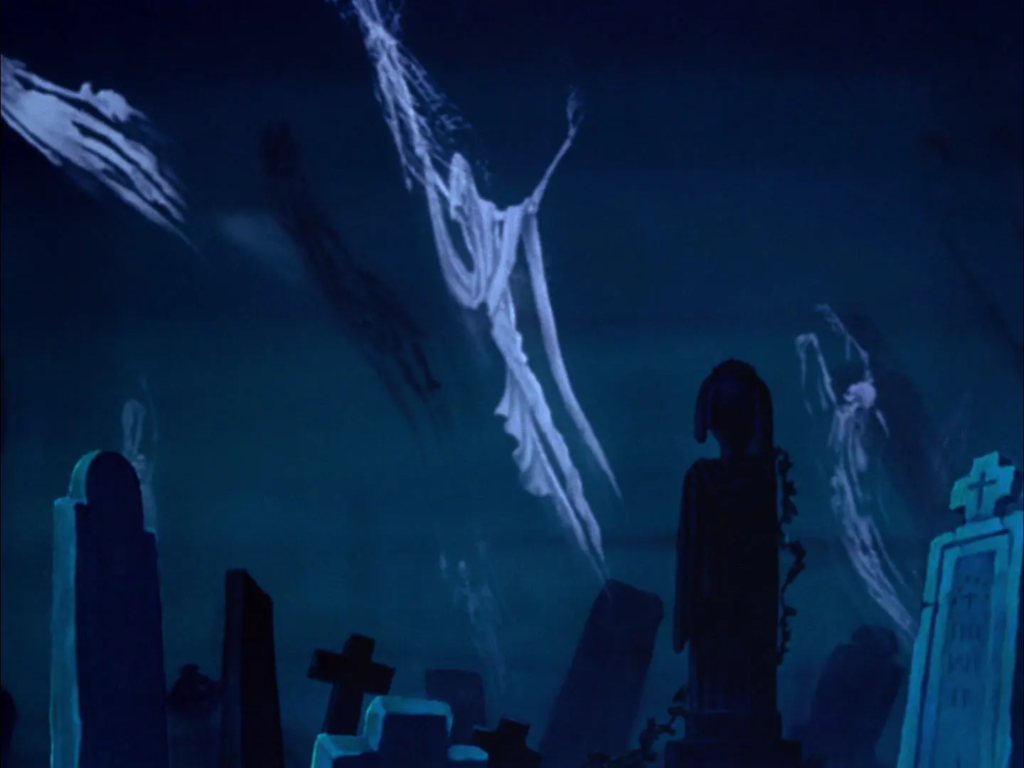
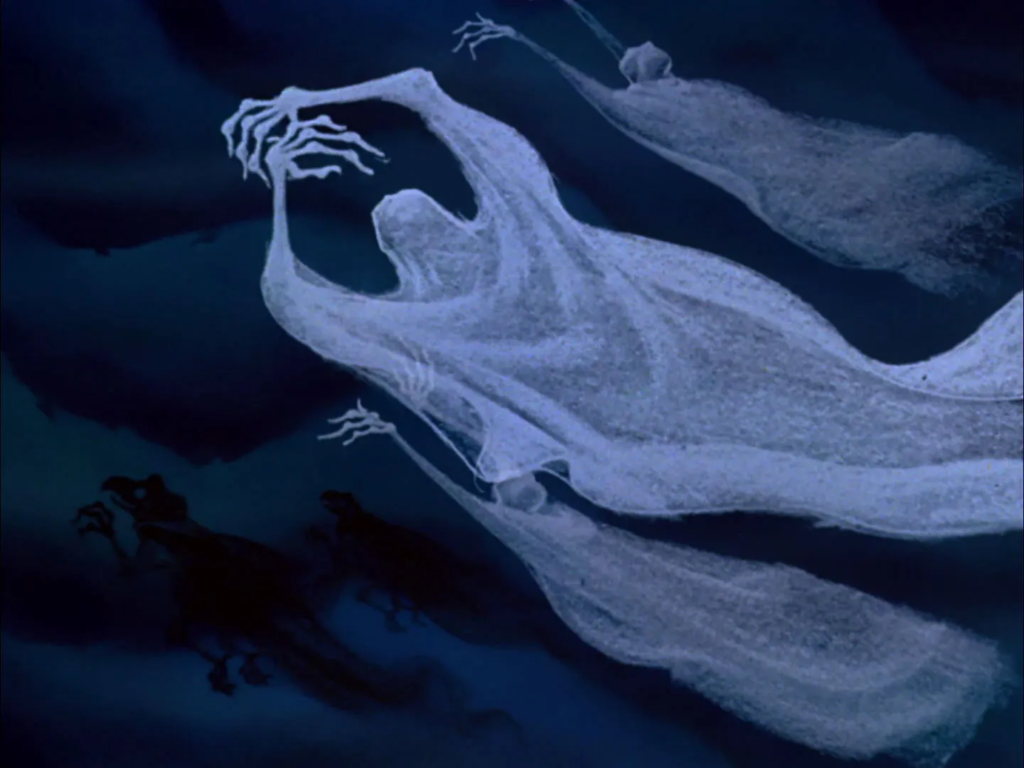
And the facial expressions of Chernabog are magnificently ugly, both completely mirthful and palpably evil and unappealing.
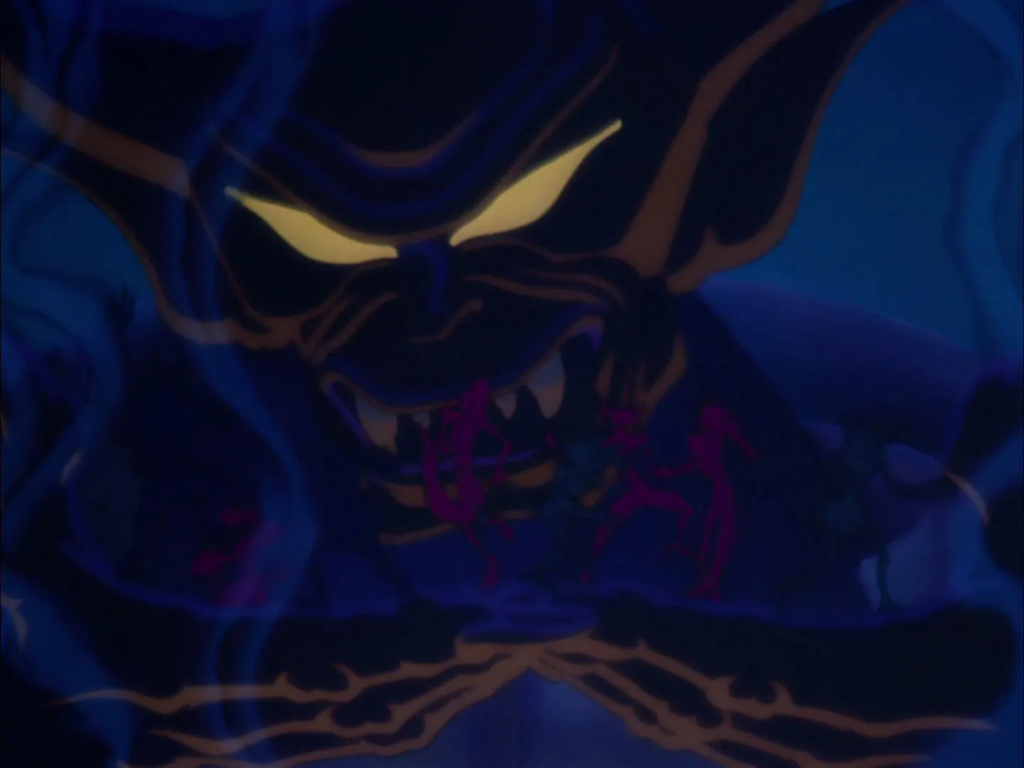
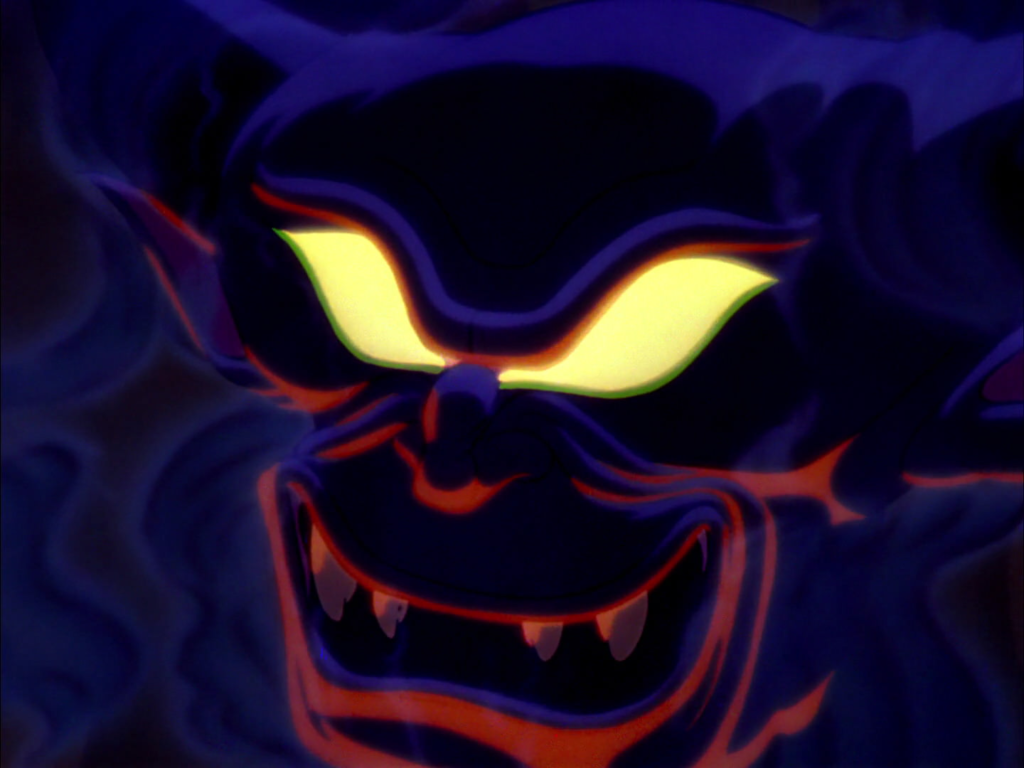
Eventually, the forces of evil are rendered impotent and sent back to sleep by the ringing of a church bell. As the sun rises and Ave Maria plays, a group of candle carrying pilgrims makes their way through a wood. It’s a very pleasant segment but it feels kind of anticlimactic. I’d have preferred something bigger and more eye catching to balance out the horrific bombast of Night on Bald Mountain. Then again, the very peacefulness of the scene makes for a good contrast to what just preceded it. No one would call Night on Bald Mountain soothing after all. And while Ave Maria’s visuals may not be as arresting, they have a definite beauty too them. I love the way the backgrounds subtly and not so subtly suggest a gothic cathedral.
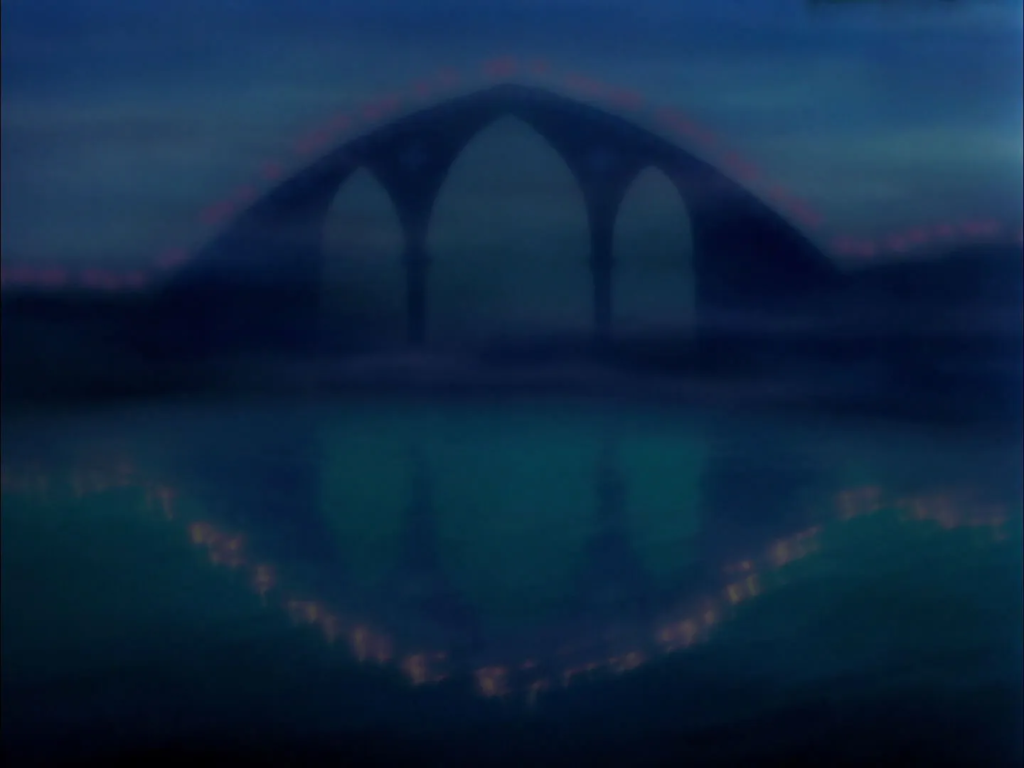
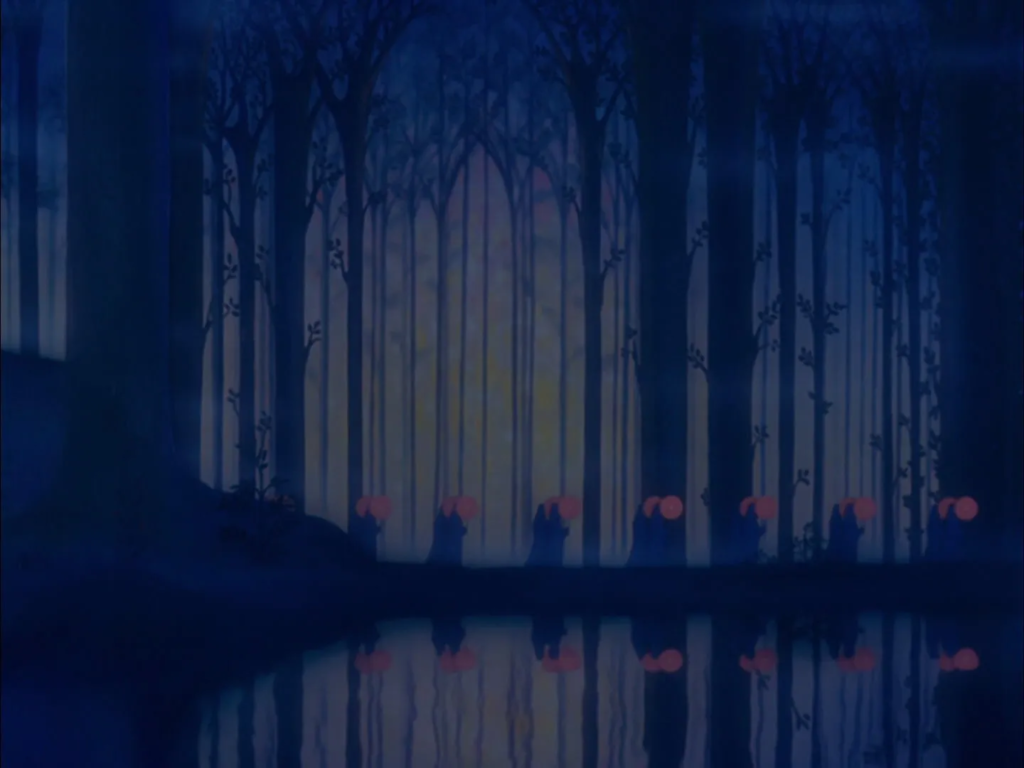
Part of me still wishes the movie could have ended on a more awesome note (no musical pun intended) but maybe I’m just ridiculously demanding considering that it ends with an image of the rising sun.[11]Apparently, at one point the Madonna and Child were going to appear but, again, this was decided to be too potentially controversial.
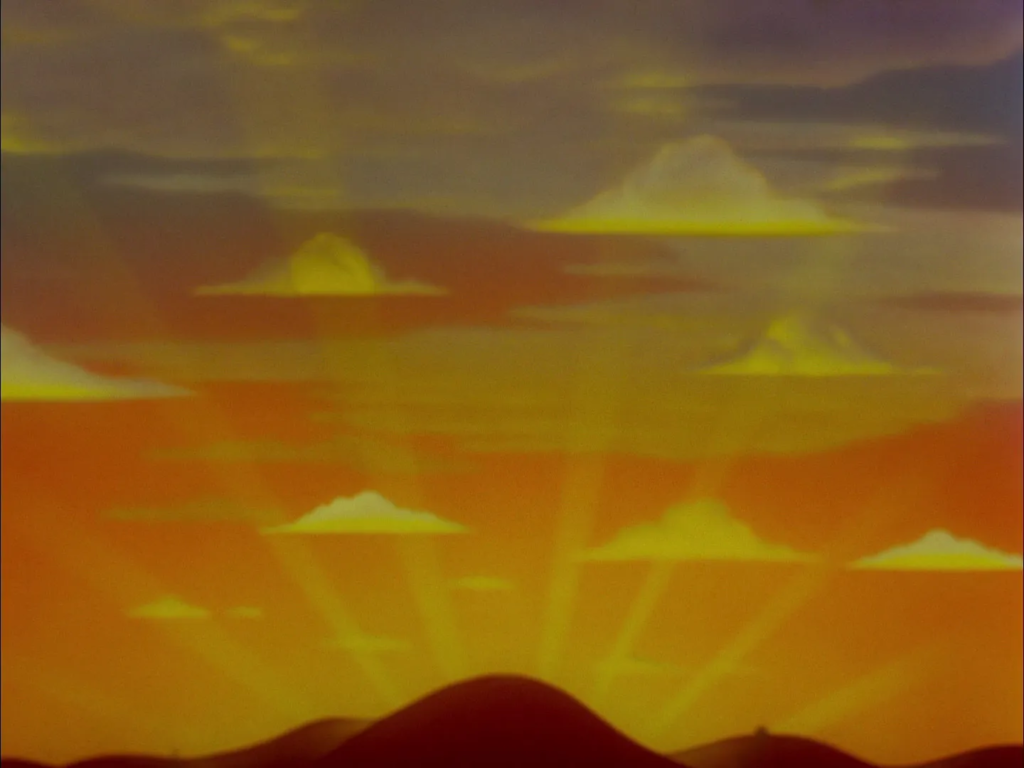
With that, Fantasia rather abruptly ends. I know this sounds crazy considering what I wrote earlier about Deems Taylor, but the movie spends so much time with him and with the orchestra that I feel they should have gotten a proper goodbye. Not only do we see the orchestra getting ready at the beginning, but we see them exiting the concert hall for the intermission, returning afterwards and having a fun little jam session. It seems like we should see them pack up at the end to complete the full concert experience.
Conclusion
So is Fantasia a masterpiece? Well, as I wrote about Les Misérables (2012), if a masterpiece is defined as a flawless work of art, perhaps not. (And if you read a lot of positive reviews of this movie, you’ll notice that its fans are willing and capable of criticizing parts of it.) But if a masterpiece is work of art the flaws of which are rendered inconsequential by its strengths, then I say yes! It’s not a movie for everyone but for its fans, it delights in ways little else does. Neither Disney nor American animation would ever make anything quite like this again.
Or would they?
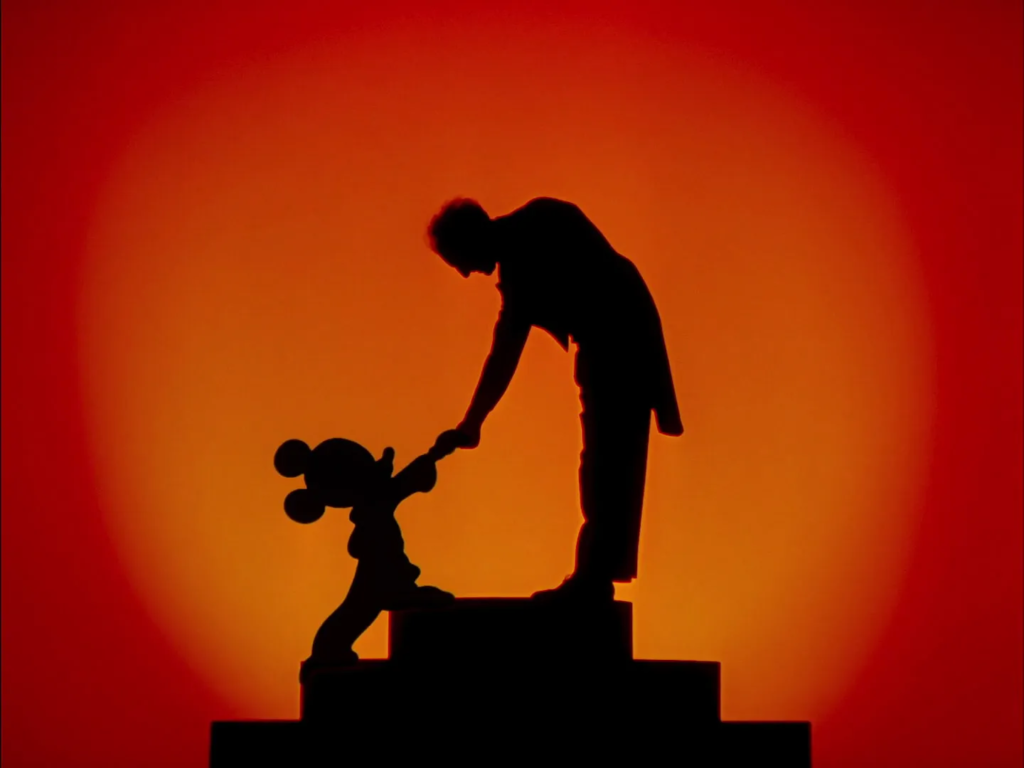
To Be Continued
Bibliography
Culhane, John. (1983) Walt Disney’s Fantasia. New York: H. N. Abrams.
References
| ↑1 | Well, of course, you don’t if you just stumbled on this blog today and aren’t a regular reader. |
|---|---|
| ↑2 | The Many Adventures of Winnie-The-Pooh is sometimes counted as one of these, but not by me since it’s a compilation of shorts that had already been made. None of them were originally intended to be part of the same film. It is an adaptation though and an interesting one, so I might actually like to do a blog post about it one day. |
| ↑3 | Just get a Star Wars enthusiastic started on the flaws of the prequels and sequels. |
| ↑4 | A much later and more crowd-pleasing Disney animated movie would do something similar with a pair of floating lanterns. |
| ↑5 | Others would argue they aren’t in conflict and that the parts of the Bible describing the creation of the world should be interpreted figuratively. I’d argue they don’t really line up with the scientific consensus whether you interpret them that way or not. Symbols have to mean something after all. Suffice to say that there are counterarguments to those arguments and more counterarguments to those…I don’t have space to do justice to everyone’s worldview and it’s not what I want to write about in this post. |
| ↑6 | Apparently, at one point they wanted to end with early man finding fire, but this was deemed too controversial. I wonder if such an ending would have made the segment come across as more optimistic or if it would have left viewers thinking that just as the dinosaurs were once on top, now mankind is and there’s no reason to believe it’ll last any longer. |
| ↑7 | The Sorcerer’s Apprentice ends with Mickey getting his butt swatted and The Dance of the Hours ends with what appears to be a symbolic representation of mass rape. Seriously. |
| ↑8 | Two black characters, who couldn’t be edited out, remain. While their puffy lips are stereotypical, they’re not as bad as the cut caricatures and while they’re also subservient to a Caucasian character, that character is Bacchus, the god of wine and revelry, not some random white person. |
| ↑9 | Of course, I’ve just given it away, ruining the reveal, but I couldn’t find a way around it. |
| ↑10 | The same thing is used in The Rite of Spring for foam and volcanic fumes. |
| ↑11 | Apparently, at one point the Madonna and Child were going to appear but, again, this was decided to be too potentially controversial. |
